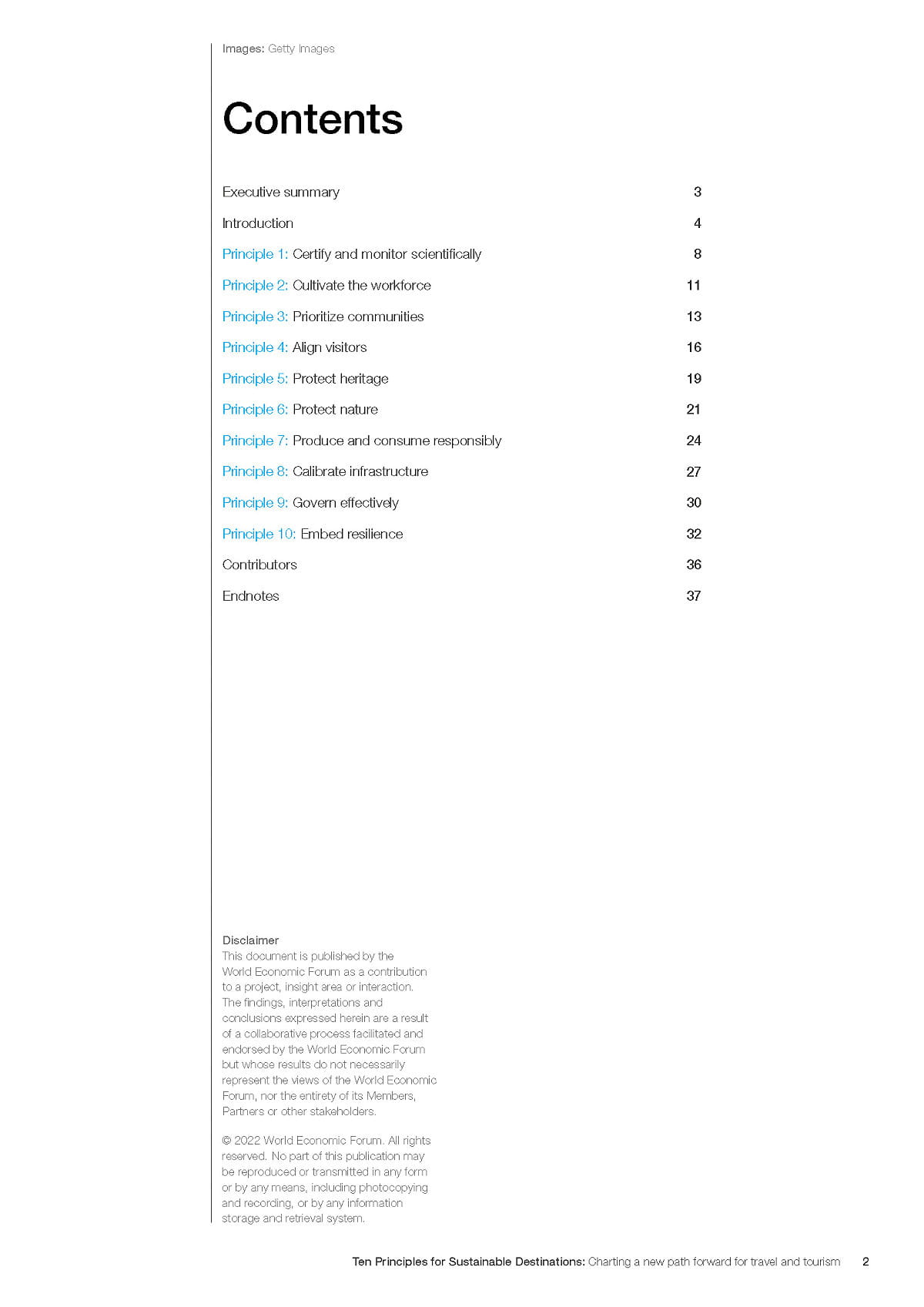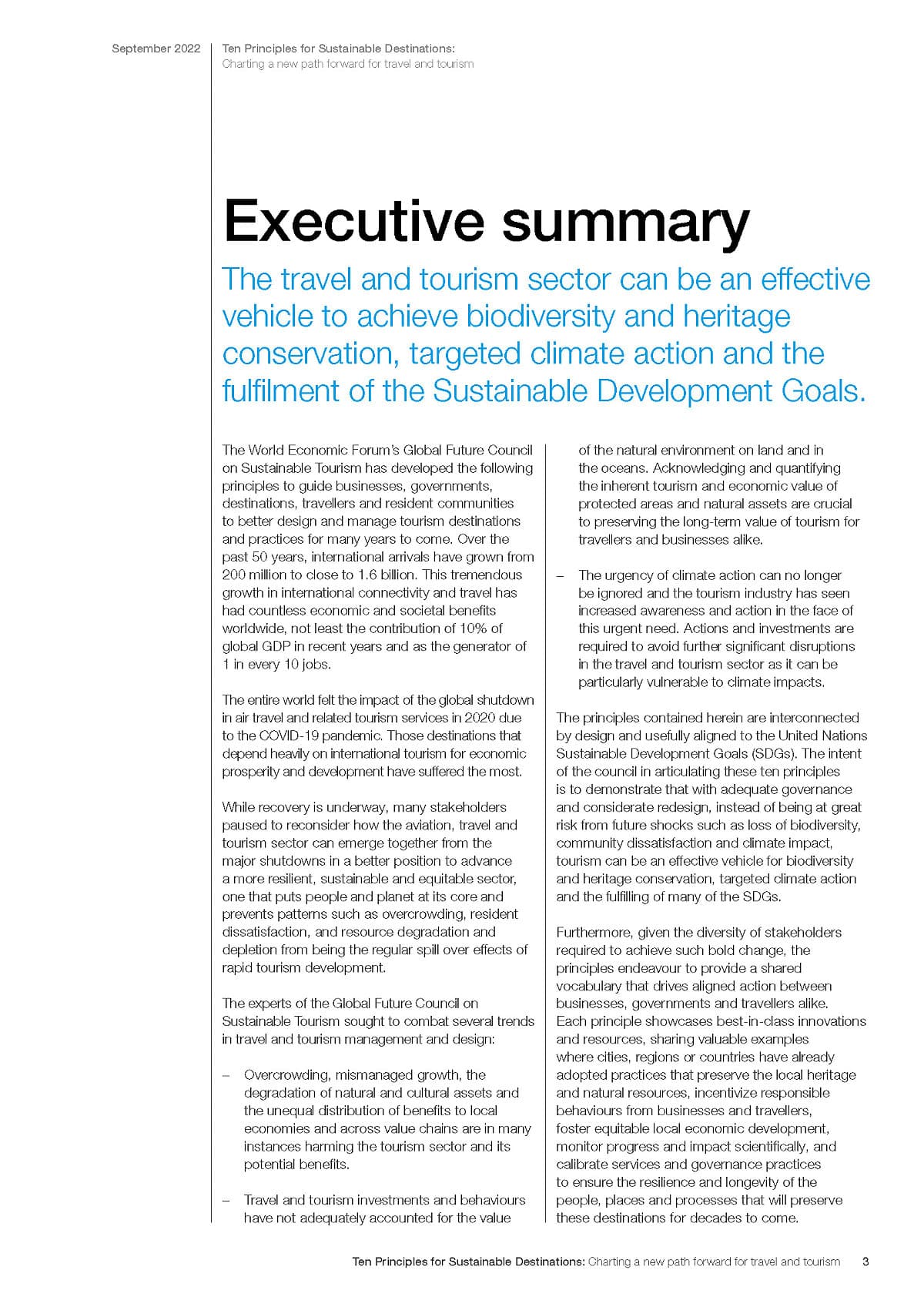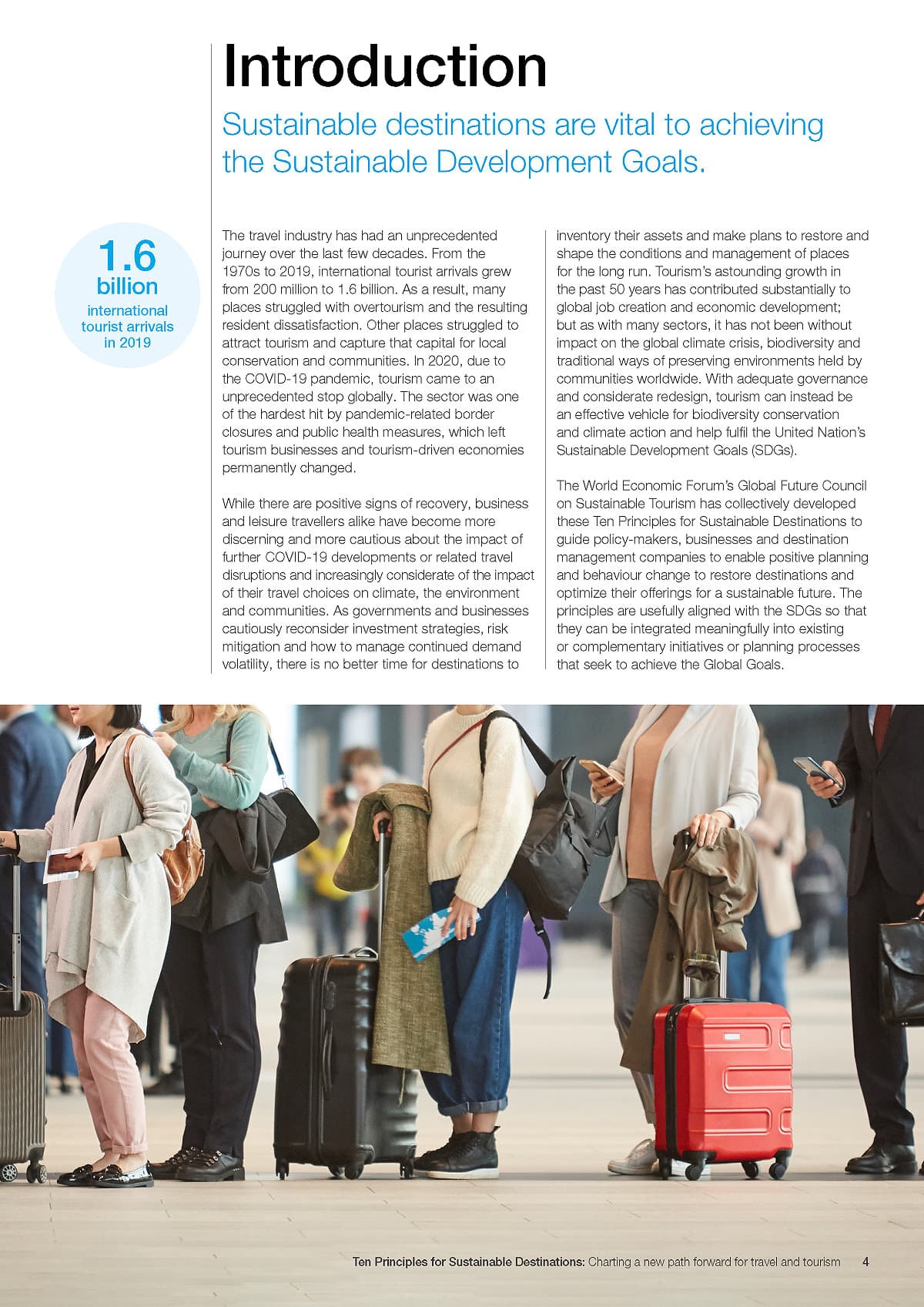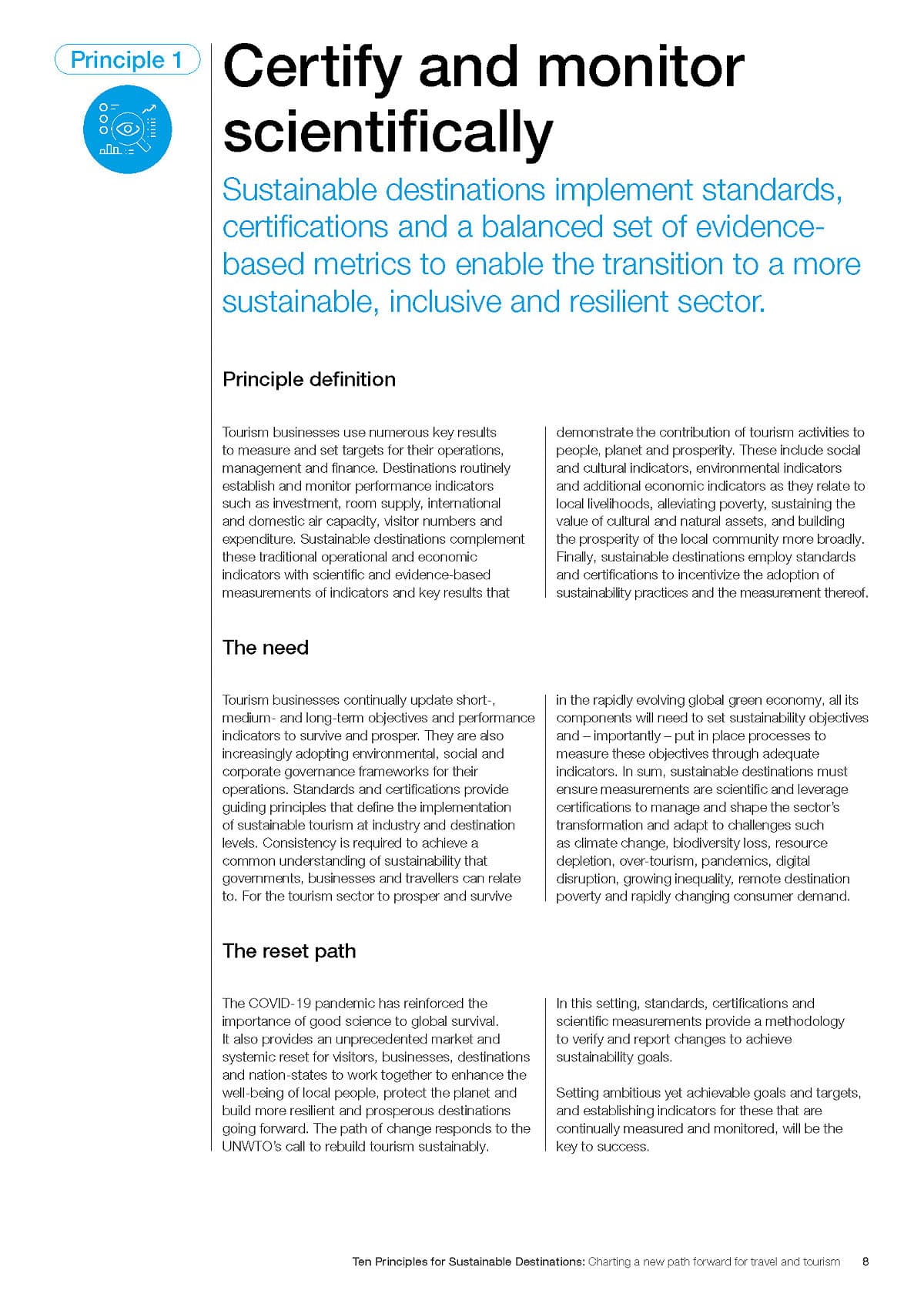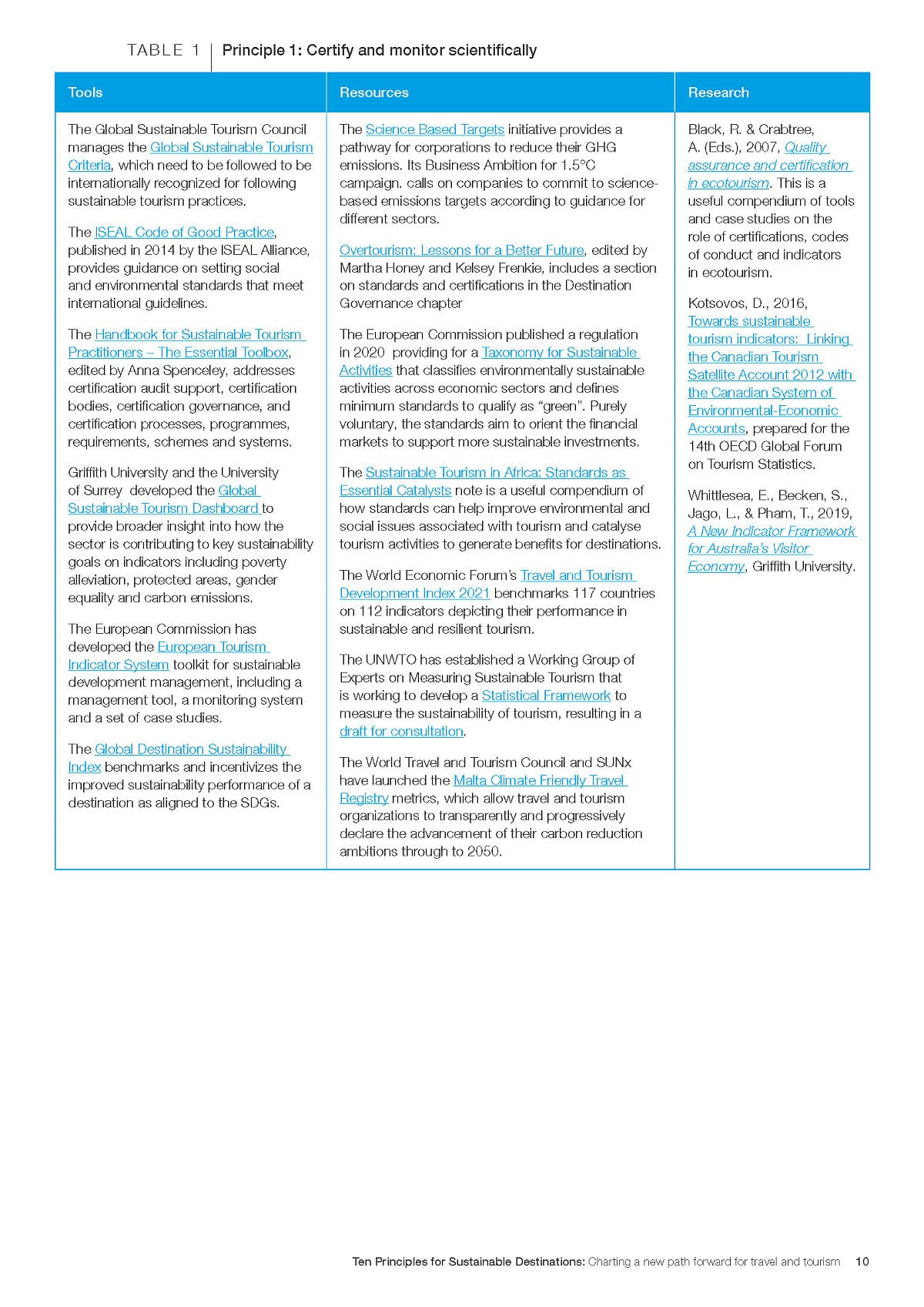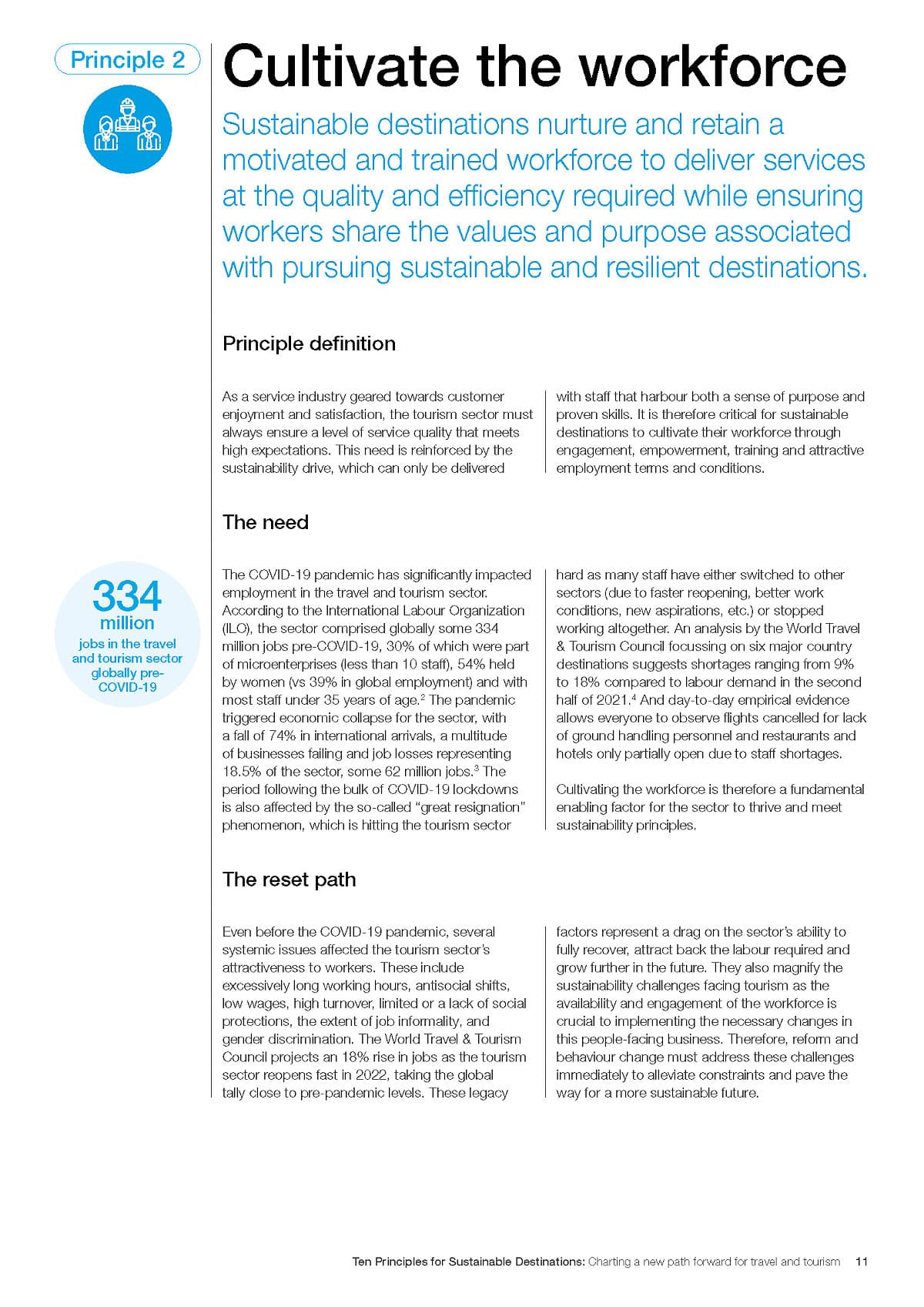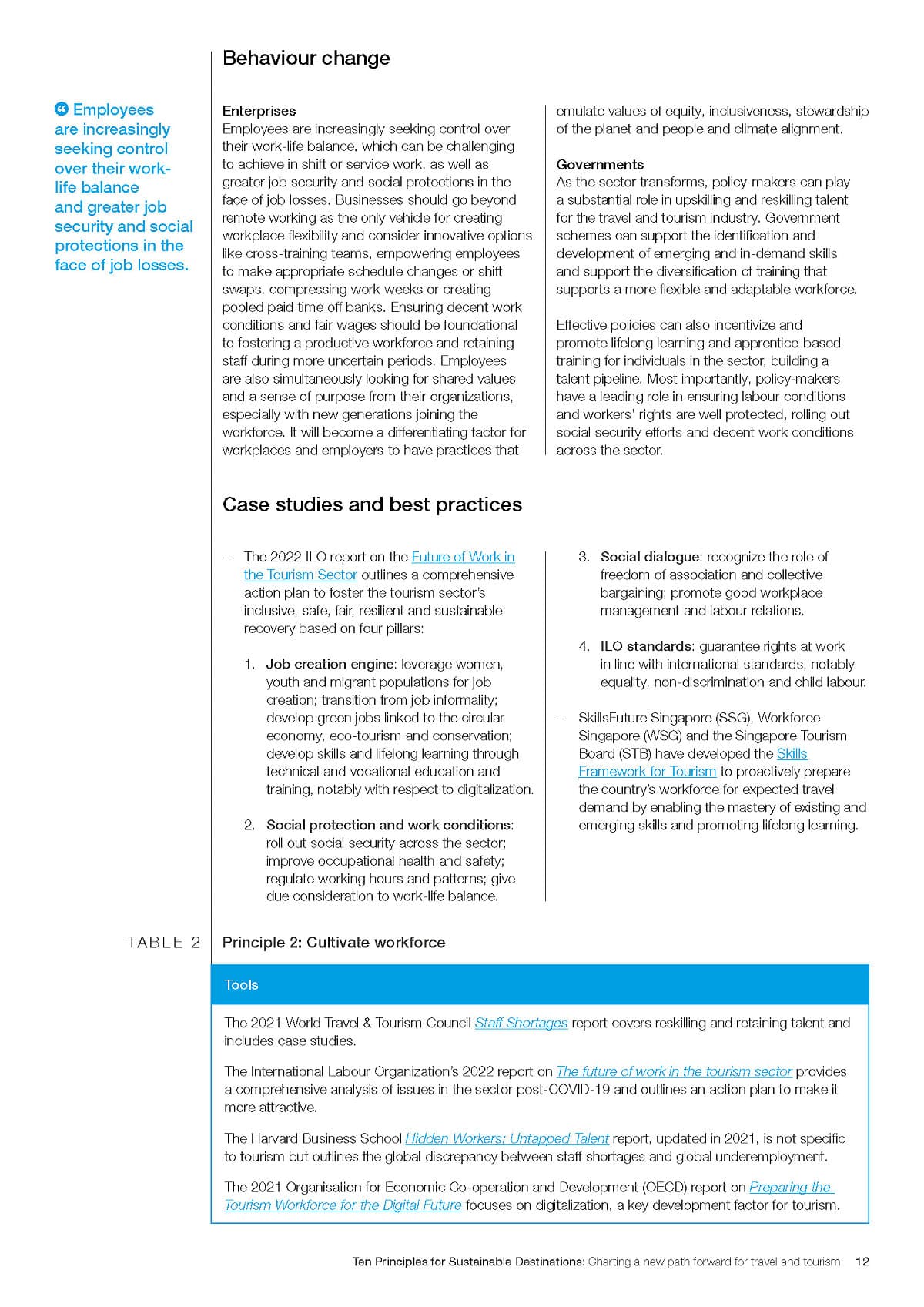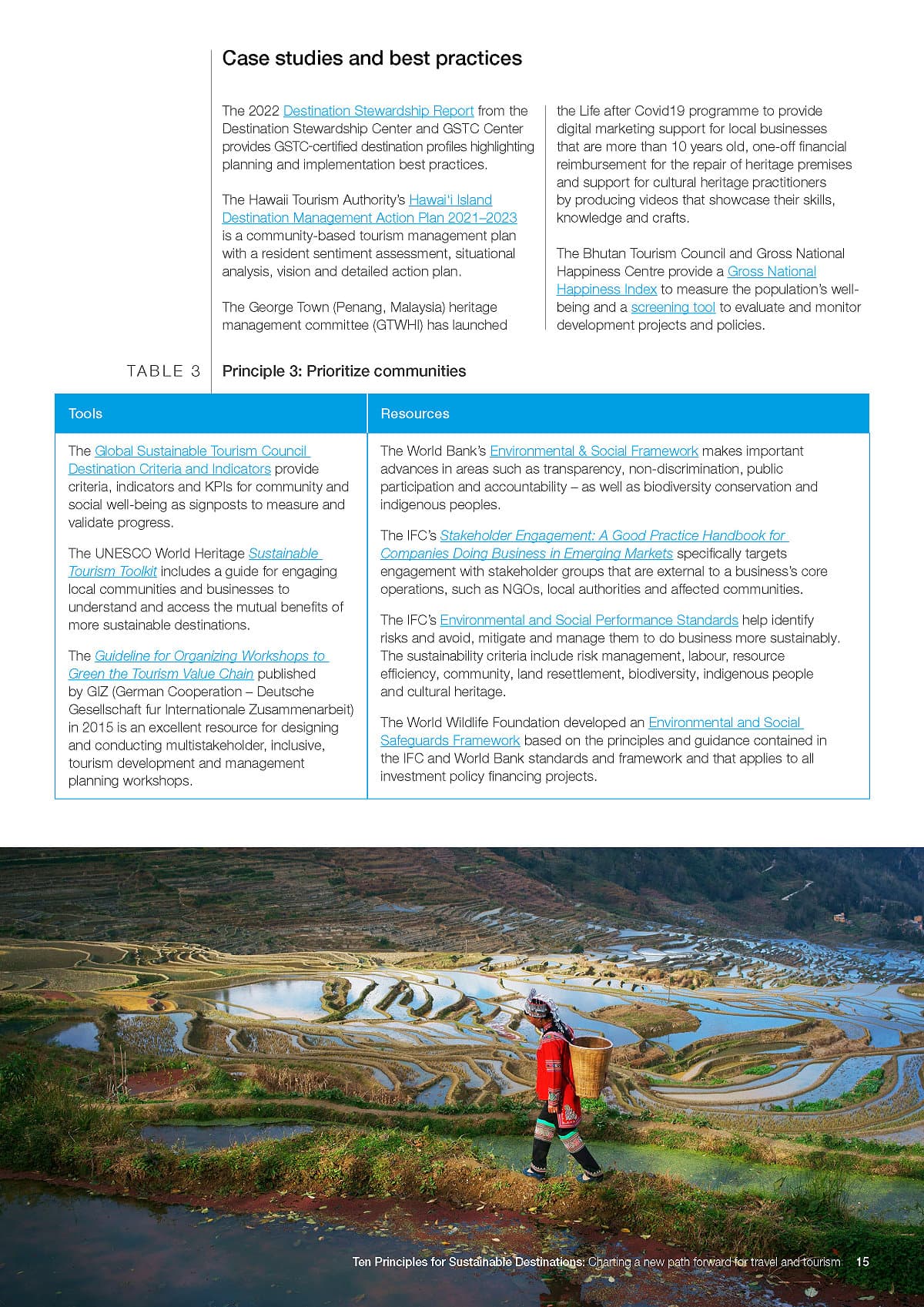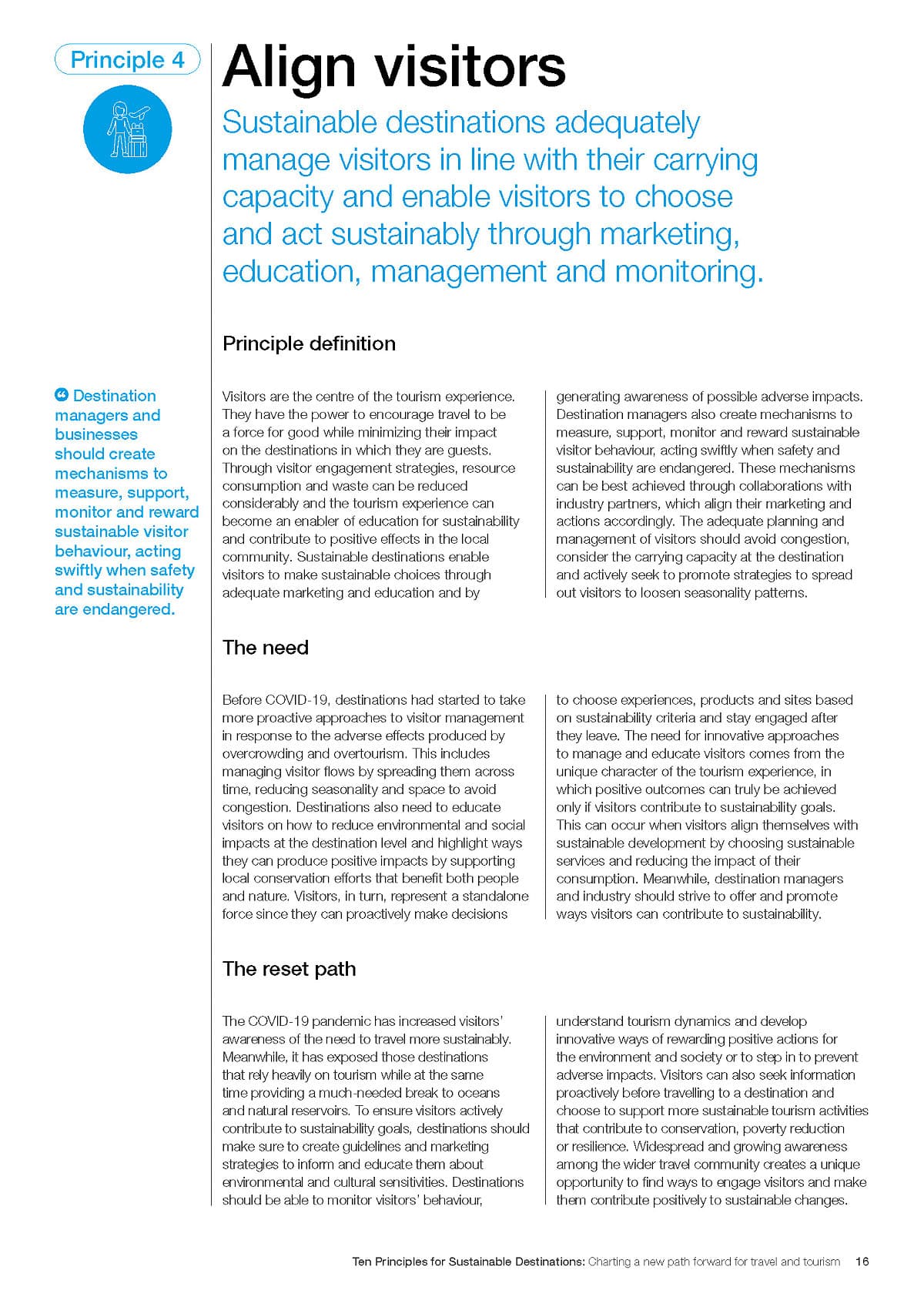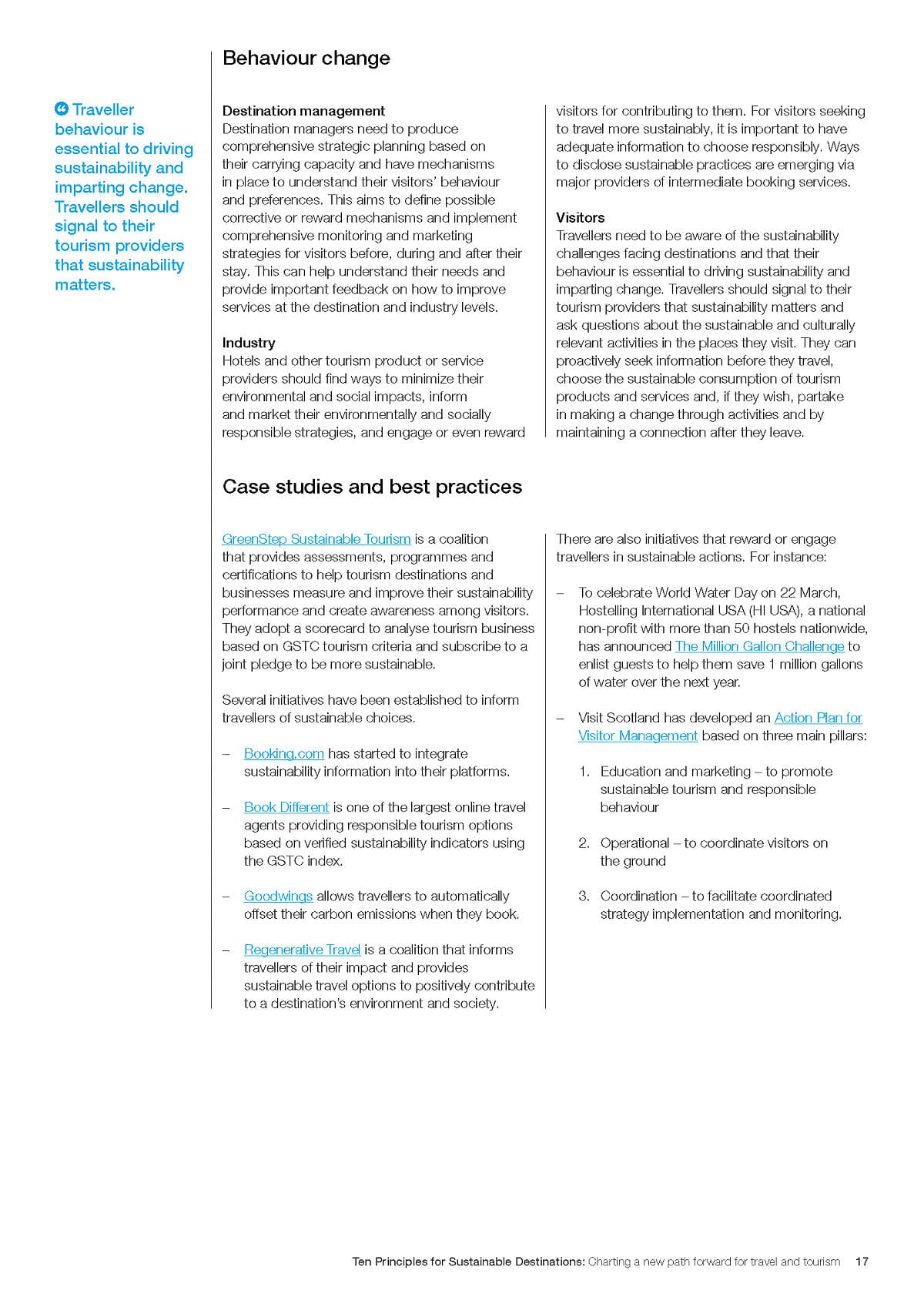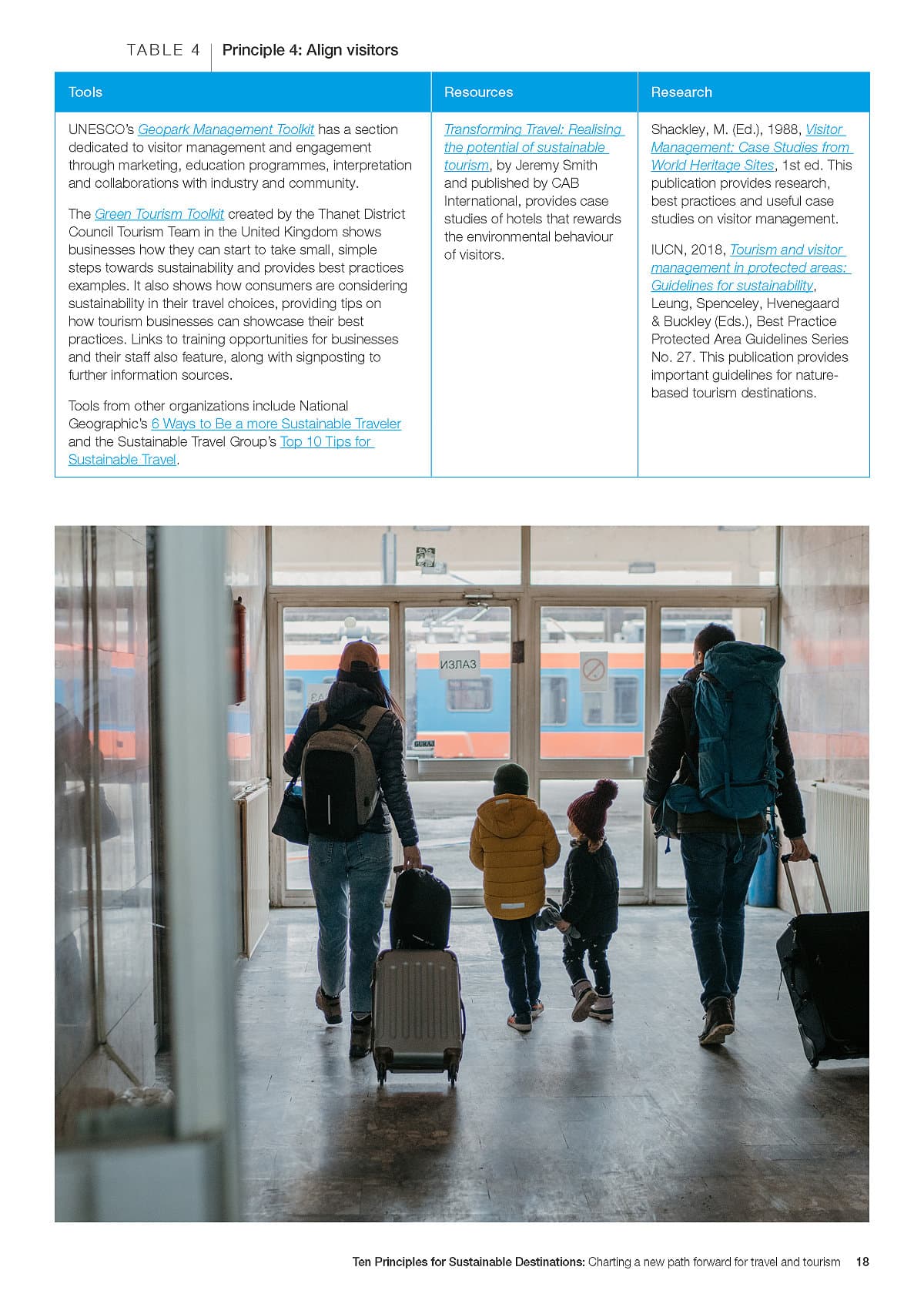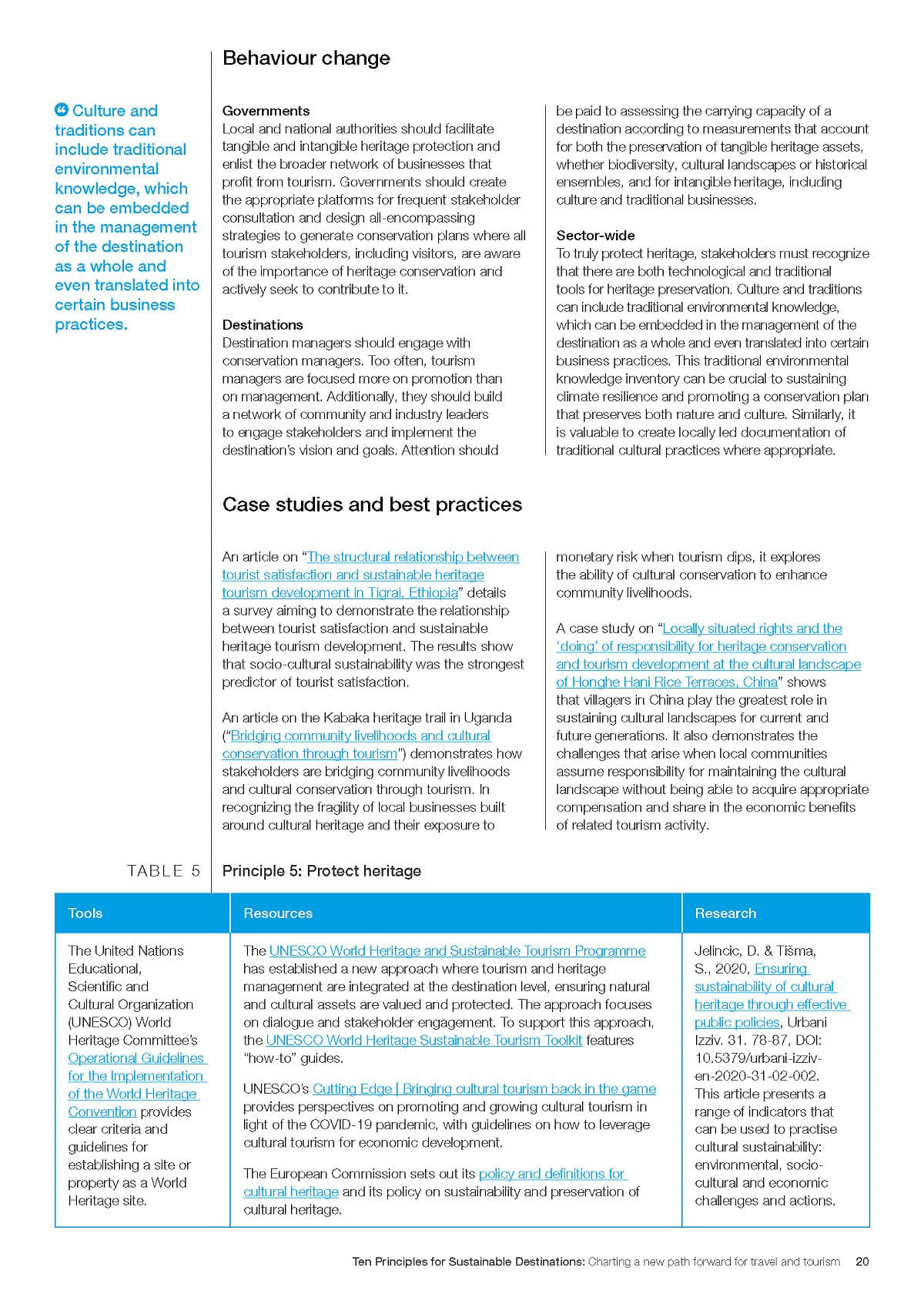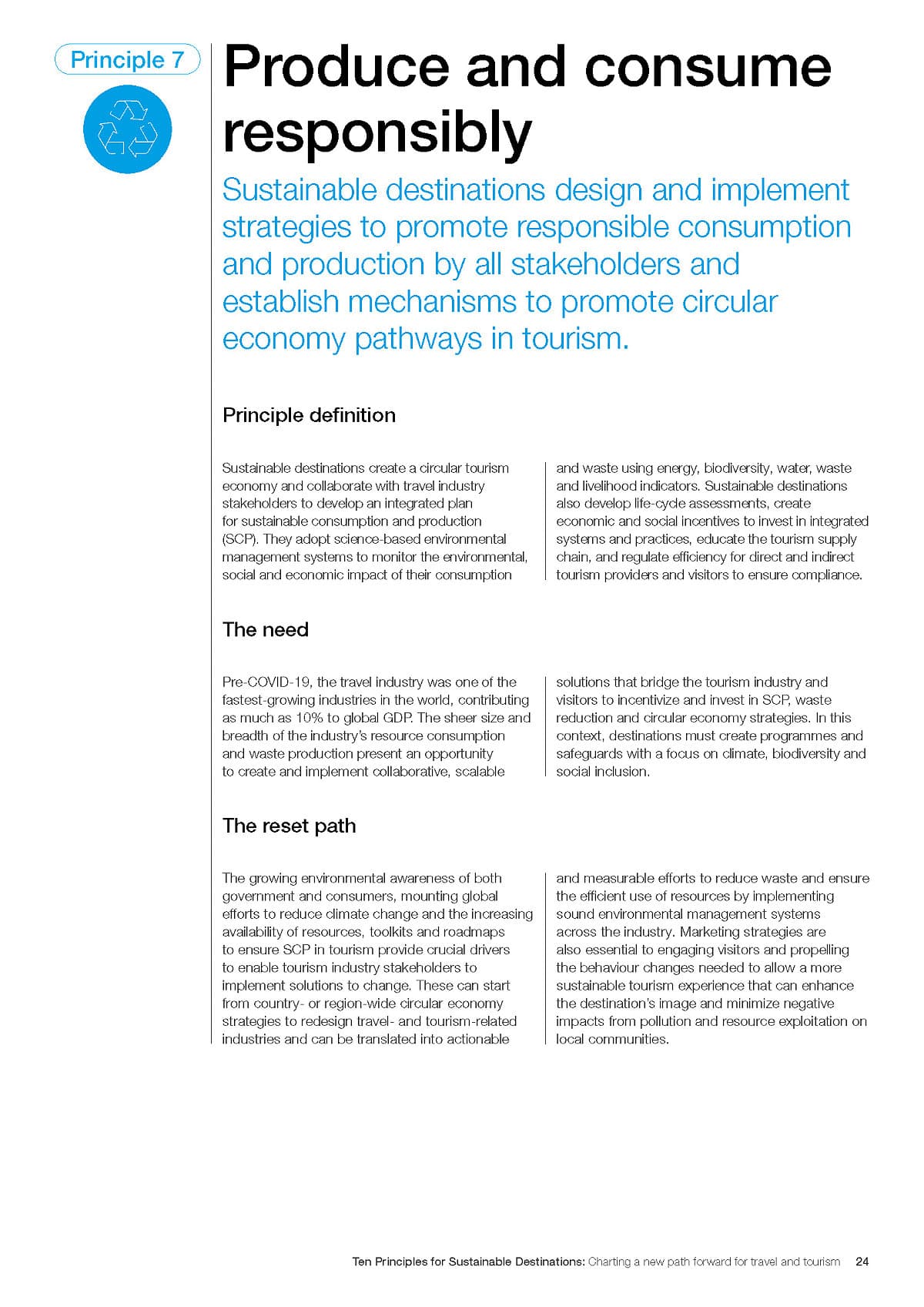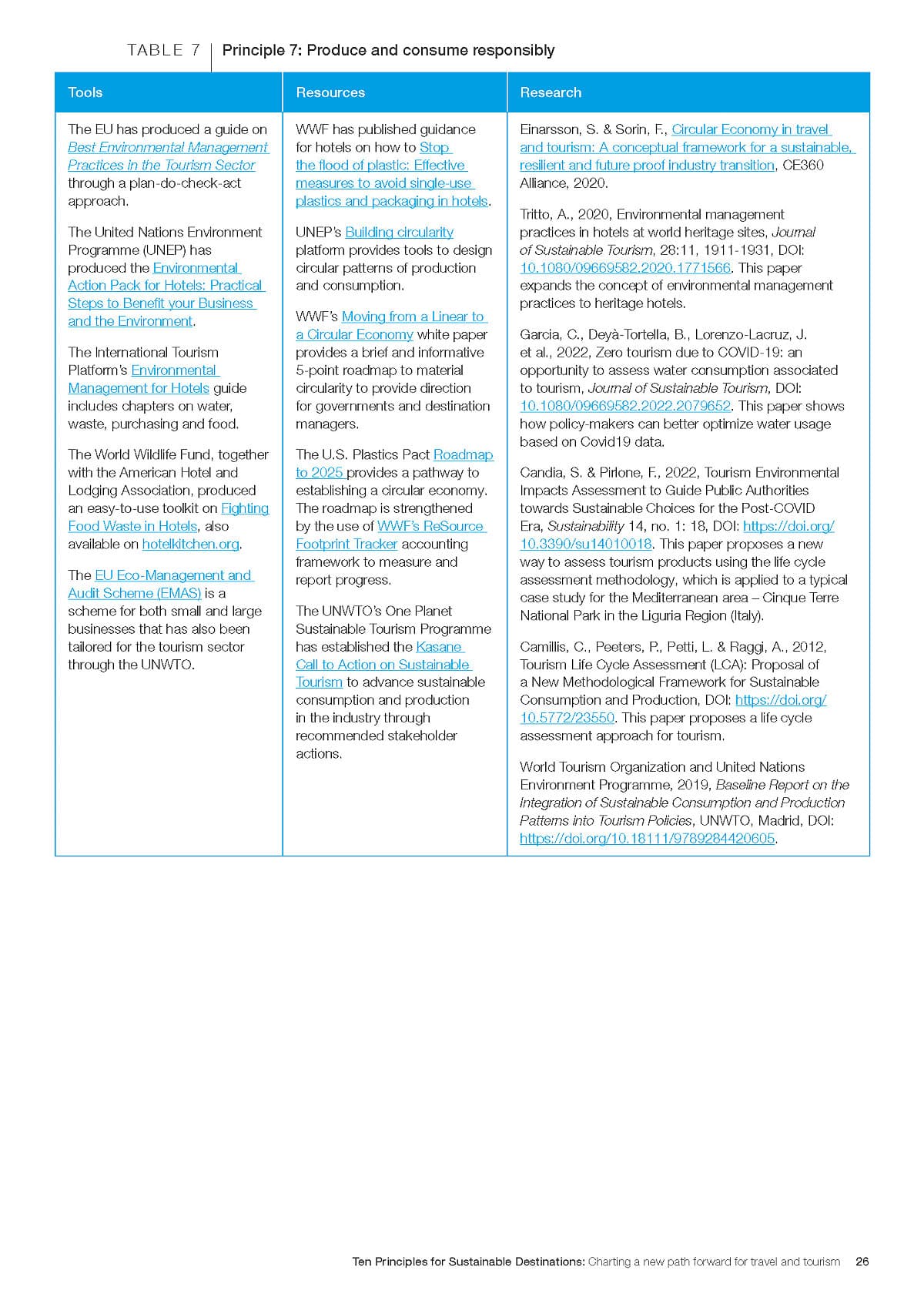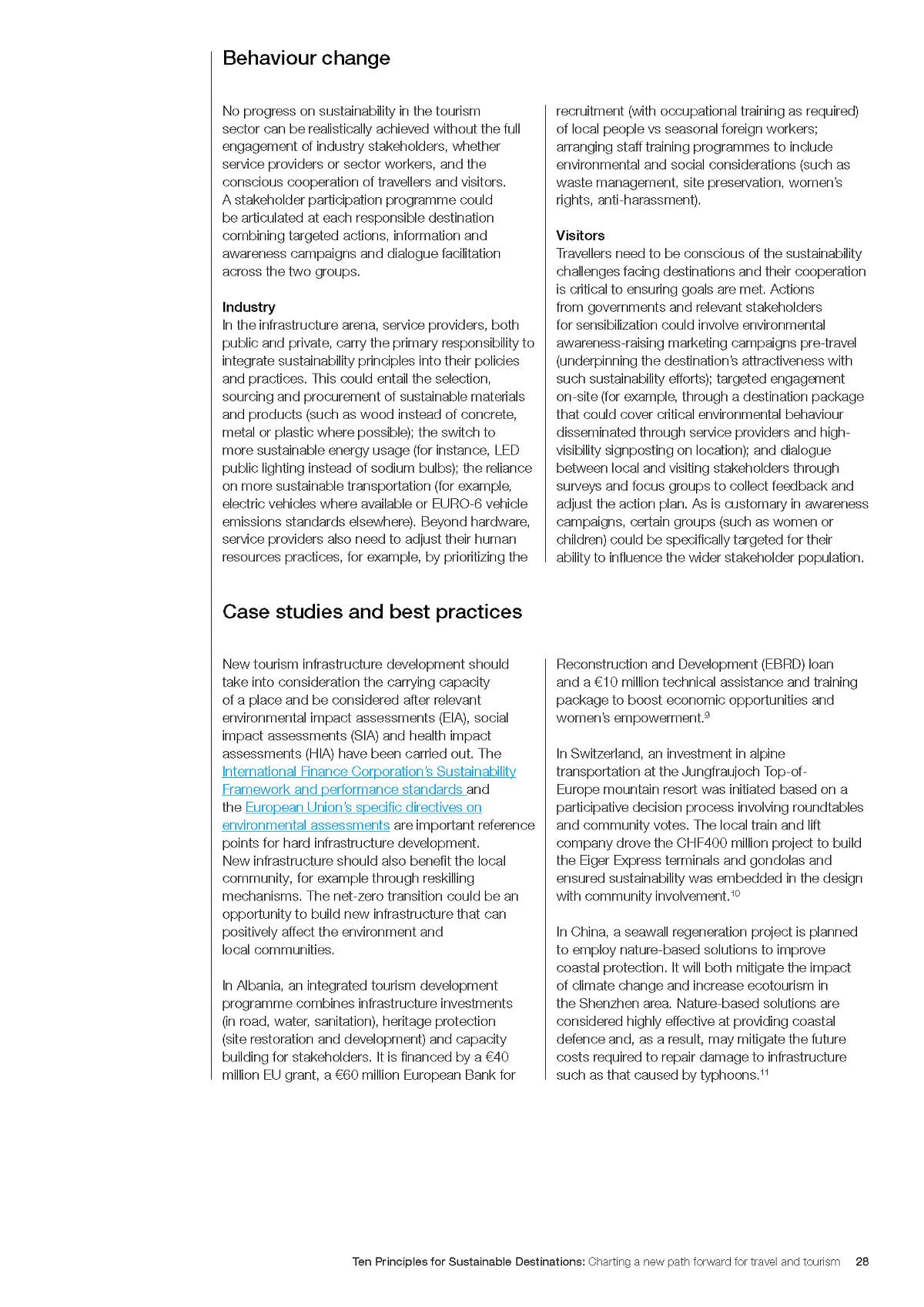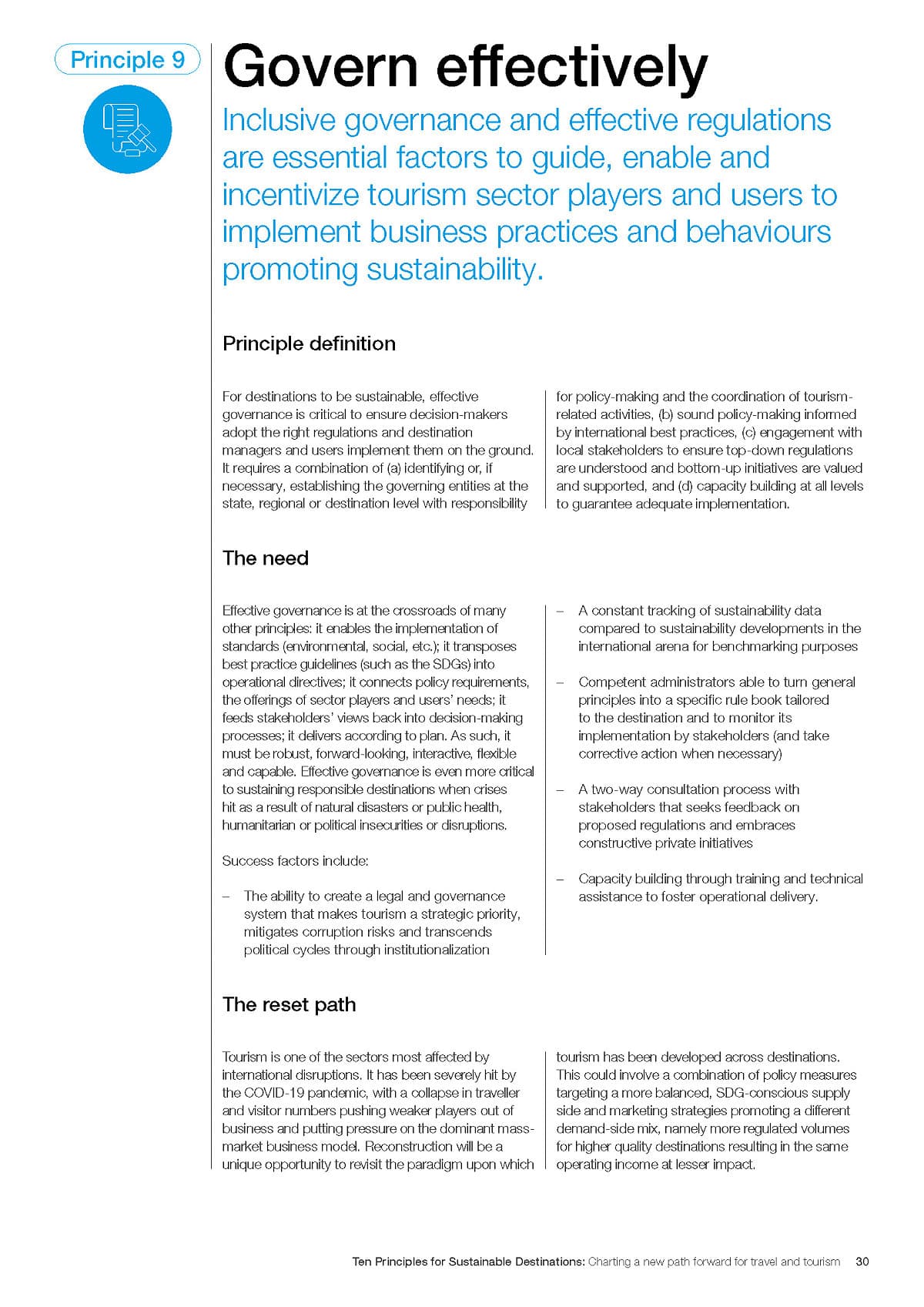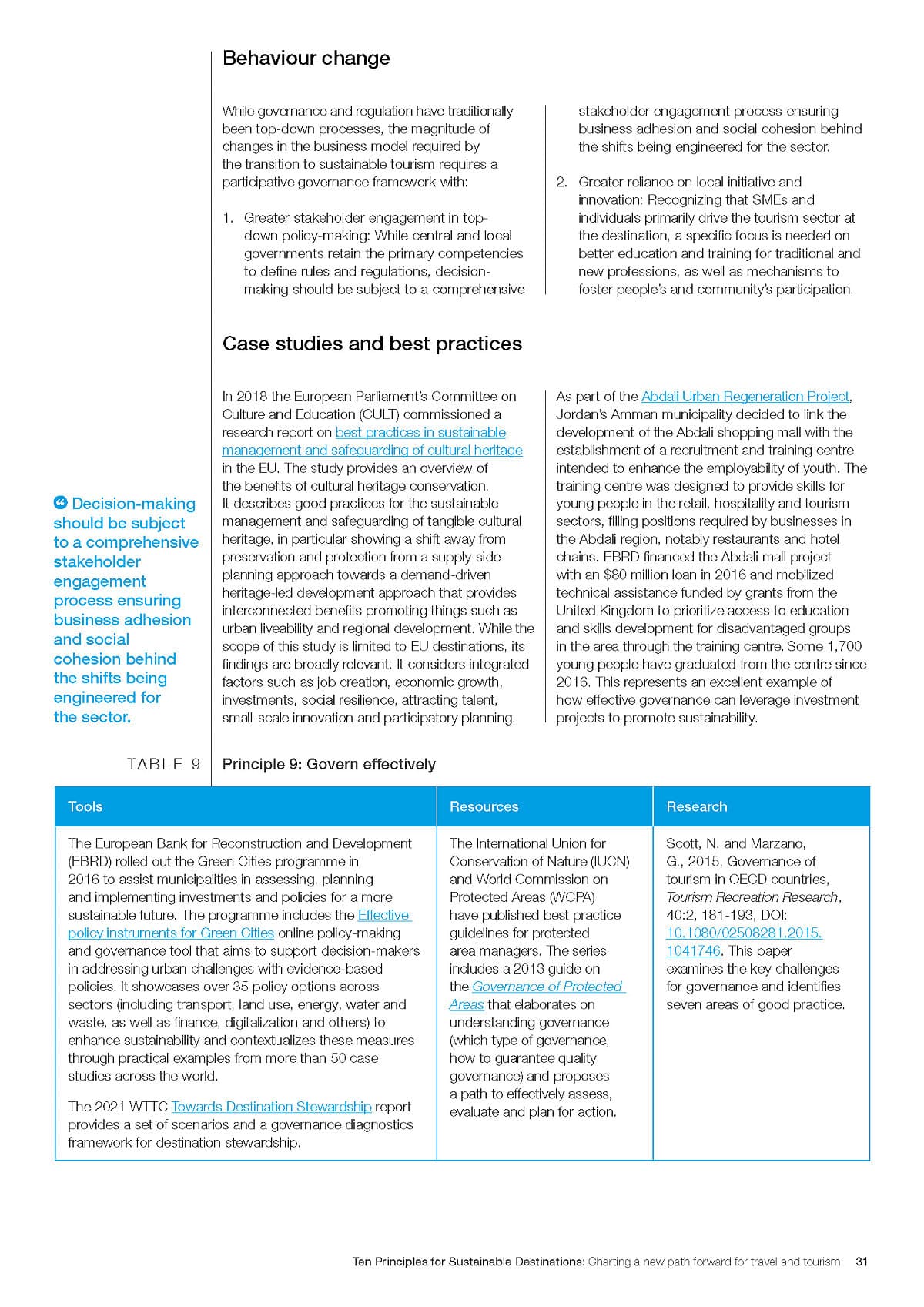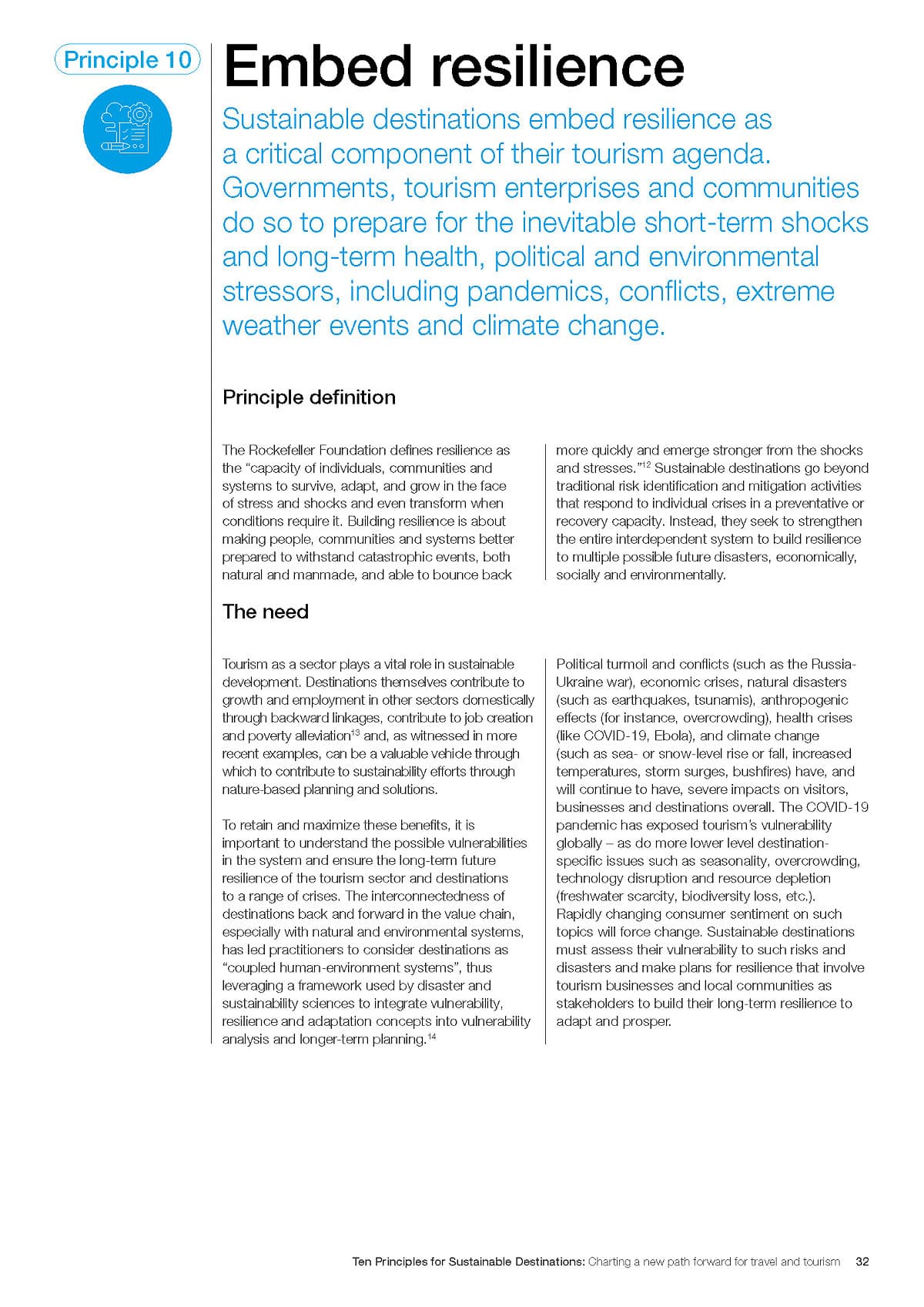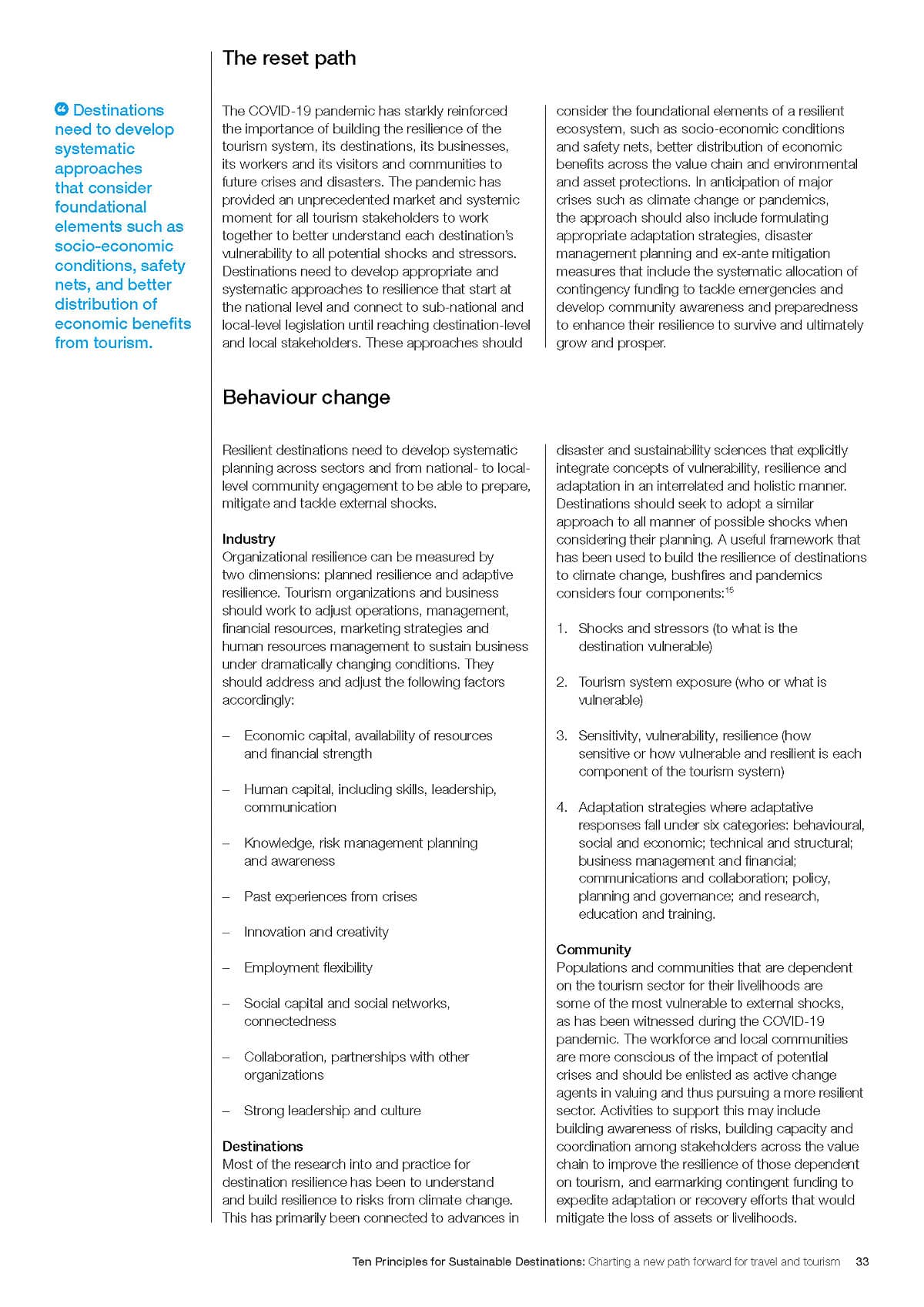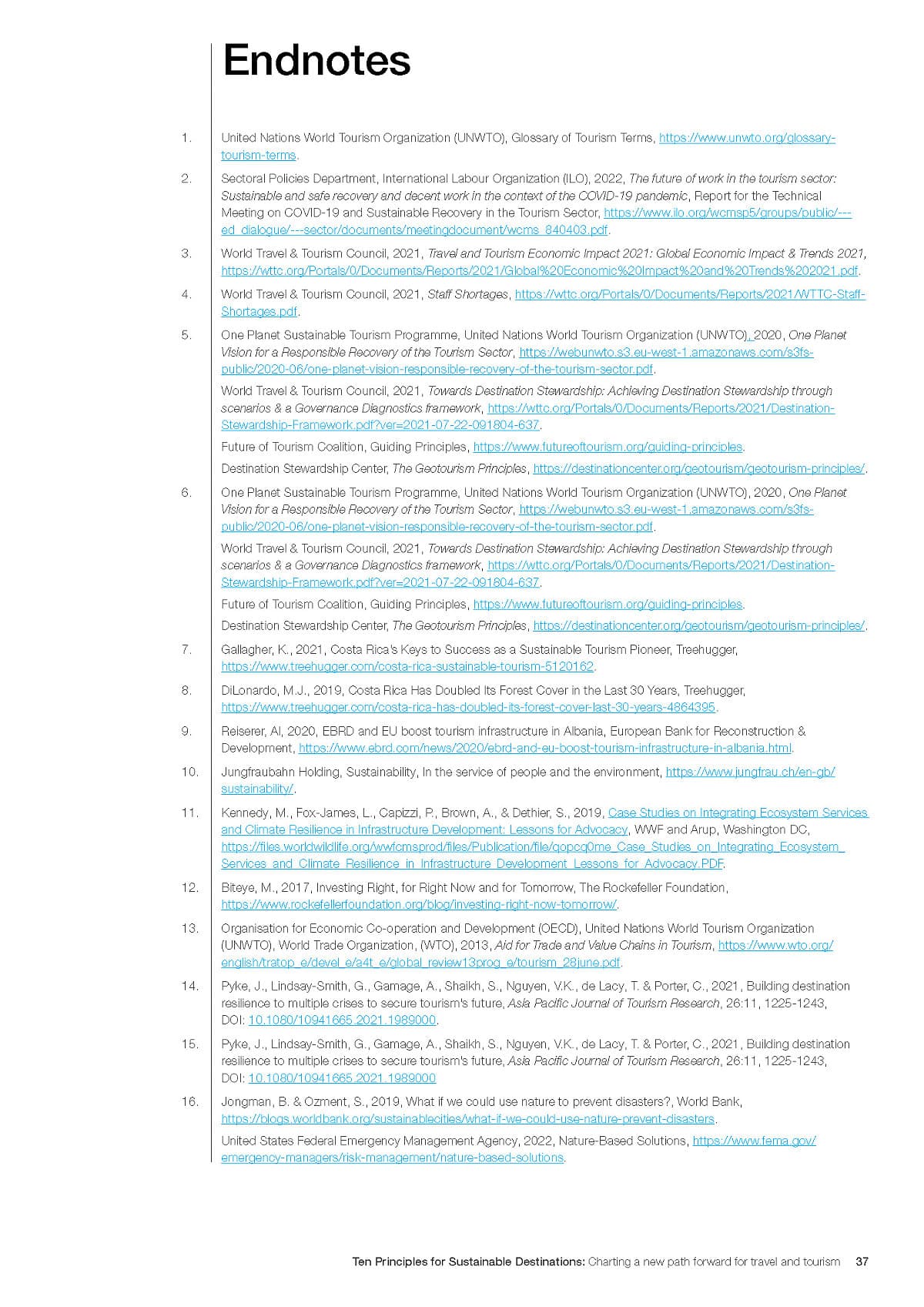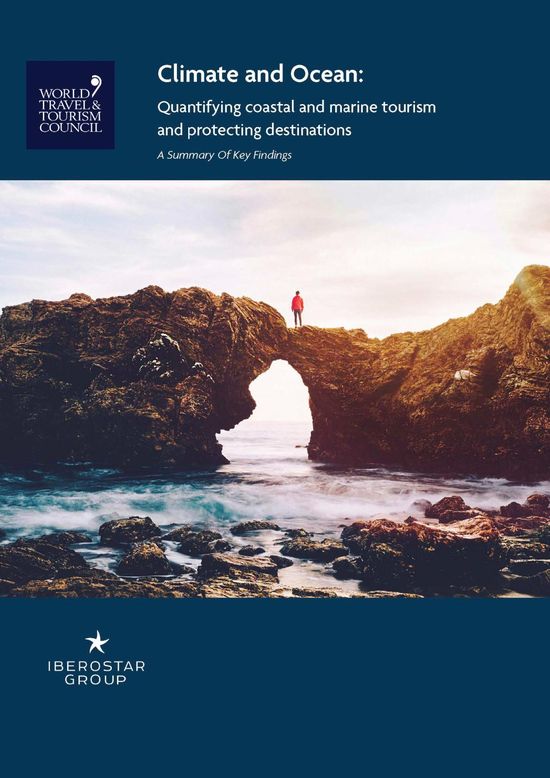前言(白皮書網站首頁)
永續旅遊目的地經營管理十大原則:為旅遊業開創一條新路
旅遊業在過去50年間的驚人增長,對全球就業市場和經濟發展有顯著貢獻;然而,與許多其他行業一樣,它對全球氣候危機、生物多樣性和全球社區保護環境的傳統方式也產生了衝擊。現在,隨著旅遊業從COVID-19疫情的災難性打擊中恢復過來,透過適當的治理和周到的重新設計,旅遊業可以成為保護生物多樣性和應對氣候行動的有效工具,有助於實現聯合國永續發展目標(SDGs)。
世界經濟論壇的永續旅遊全球未來理事會制定了十項永續旅遊目的地經營管理原則,旨在引導政策制定者、企業和旅遊目的地管理機構,以積極的規劃和行為改變來重振目的地並優化永續發展的未來。這些原則與SDGs是一致的,因此它們可以兼容並蓄地整合到現有或互補的計畫中,以實現全球永續發展目標。
配合2022年世界旅遊日主題「重新思考旅遊」,本文介紹的十項原則為權益相關方提供了指引、最佳實踐案例和可以參考運用的工具,以合作和有效地重新思考如何經營管理旅遊目的地和旅遊實務;有意並主動地設計以提高當地、人民和產品的韌性與永續性。(編按:以下將「旅遊目的地」簡稱為「目的地」或「旅遊地」)
Ten Principles for Sustainable Destinations: Charting a new path forward for travel and tourism
Tourism’s astounding growth in the past 50 years has contributed substantially to global job creation and economic development; but as with many sectors, it has not been without impact on the global climate crisis, biodiversity and traditional ways of preserving environments held by communities worldwide. Now as the sector recovers from the disastrous impact of the COVID19 pandemic, with adequate governance and considerate redesign, tourism can instead become an effective vehicle for biodiversity conservation and climate action and help fulfil the United Nation’s Sustainable Development Goals (SDGs).
The World Economic Forum’s Global Future Council on Sustainable Tourism has collectively developed these Ten Principles for Sustainable Destinations to guide policy-makers, businesses and destination management companies to enable positive planning and behaviour change to restore destinations and optimize their offerings for a sustainable future. The principles are usefully aligned with the SDGs so that they can be integrated meaningfully into existing or complementary initiatives or planning processes that seek to achieve the Global Goals.
Launched on World Tourism Day 2022, under the global theme of “Rethinking Tourism”, the 10 principles presented in this paper provide guidance, best practices and possible tools for stakeholders to collaboratively and effectively reconsider how they manage destinations and tourism practices; deliberately and proactively designing for the resilience and sustainability of the place, the people and the products it includes.
全文PDF檔下載:https://www3.weforum.org/docs/WEF_Ten_Principles_for_Sustainable_Destinations_2022.pdf
摘要(白皮書第3頁)
旅遊業可以成為保護生物多樣性和文化遺產、應對氣候行動以及實現永續發展目標的有效工具。
世界經濟論壇的永續旅遊全球未來理事會制定了以下原則,旨在指引企業、政府、目的地、旅行者和社區居民更好地規劃和管理未來數年的旅遊目的地和實務。在過去50年,國際旅客人數從2億增加到接近16億。這種國際連通性和旅遊業的巨大成長在全世界帶來了無數的經濟和社會利益,特別是近年來對全球GDP的貢獻率達到10%,並且在每10個工作崗位中就有1個是因旅遊需求而產生的工作機會。
由於COVID-19大流行導致全球航空旅行和相關旅遊服務的全面關閉,那些高度依賴國際旅遊促進經濟繁榮和發展的目的地受到了最嚴重的打擊。

儘管恢復工作陸續進展,但許多權益相關者則冷靜下來重新思考航空業、旅遊業如何共同走出陰霾,以更具韌性、永續性和公平的方式前進,將人和地球放在核心,防止超限擁擠、居民不滿以及環境資源的退化和耗盡等旅遊快速發展常出現的不良外溢效應。
永續旅遊全球未來理事會的專家們試圖解決旅遊業管理和設計中過往的幾個問題:
- 超限擁擠、增長失控、自然和文化資產的退化,以及許多情況下旅遊效益對當地經濟和價值鏈並未均衡分配,都對旅遊業及其潛在價值造成傷害。
- 旅遊業的投資和措施未充分考慮陸地和海洋的自然環境價值。長期而言,對旅遊業最重要的是,應承認和量化保護區與自然資產在旅遊和經濟上的隱性價值。
- 緊急氣候行動的急迫性不容忽視,而旅遊業在面對這一迫切需求時也已提高了警覺性和作為。旅遊業特別容易受到氣候的影響,所以更需要採取行動和投資,以避免受到更多更大的干擾。
這些原則在設計上相互關聯,並契合聯合國永續發展目標(SDGs)。理事會制定這十項原則是為了強調通過適當的治理和周到的重新設計,旅遊業可以成為保護生物多樣性和文化遺產、應對氣候行動以及實現許多SDGs的有效工具,而不是面臨未來生物多樣性喪失、社區不滿和氣候影響的風險。
此外,因為要結合眾多的權益相關者一起實現如此重大的變革,這些原則就是提供一個共享的語彙,以協調企業、政府和遊客之間的行動。每個原則都展示了最佳創新和資源的案例,分享了城市、地區或國家已經採用的實務,看他們如何保護當地的文化遺產和自然資源,激勵企業和遊客對環境負責任的行為,促進旅遊地公平的經濟發展,科學地監測旅遊發展和影響,並校準服務和治理實務,以確保人民、地方和發展過程的韌性及持久,維護這些目的地未來的幾十年。
Executive summary
The travel and tourism sector can be an effective vehicle to achieve biodiversity and heritage conservation, targeted climate action and the fulfilment of the Sustainable Development Goals.
The World Economic Forum’s Global Future Council on Sustainable Tourism has developed the following principles to guide businesses, governments, destinations, travellers and resident communities to better design and manage tourism destinations and practices for many years to come. Over the past 50 years, international arrivals have grown from 200 million to close to 1.6 billion. This tremendous growth in international connectivity and travel has had countless economic and societal benefits worldwide, not least the contribution of 10% of global GDP in recent years and as the generator of 1 in every 10 jobs.
The entire world felt the impact of the global shutdown in air travel and related tourism services in 2020 due to the COVID-19 pandemic. Those destinations that depend heavily on international tourism for economic prosperity and development have suffered the most.
While recovery is underway, many stakeholders paused to reconsider how the aviation, travel and tourism sector can emerge together from the major shutdowns in a better position to advance a more resilient, sustainable and equitable sector, one that puts people and planet at its core and prevents patterns such as overcrowding, resident dissatisfaction, and resource degradation and depletion from being the regular spill over effects of rapid tourism development.
The experts of the Global Future Council on Sustainable Tourism sought to combat several trends in travel and tourism management and design:
– Overcrowding, mismanaged growth, the degradation of natural and cultural assets and the unequal distribution of benefits to local economies and across value chains are in many instances harming the tourism sector and its potential benefits.
– Travel and tourism investments and behaviours have not adequately accounted for the value of the natural environment on land and in the oceans. Acknowledging and quantifying the inherent tourism and economic value of protected areas and natural assets are crucial to preserving the long-term value of tourism for travellers and businesses alike.
– The urgency of climate action can no longer be ignored and the tourism industry has seen increased awareness and action in the face of this urgent need. Actions and investments are required to avoid further significant disruptions in the travel and tourism sector as it can be particularly vulnerable to climate impacts.
The principles contained herein are interconnected by design and usefully aligned to the United Nations Sustainable Development Goals (SDGs). The intent of the council in articulating these ten principles is to demonstrate that with adequate governance and considerate redesign, instead of being at great risk from future shocks such as loss of biodiversity, community dissatisfaction and climate impact, tourism can be an effective vehicle for biodiversity and heritage conservation, targeted climate action and the fulfilling of many of the SDGs.
Furthermore, given the diversity of stakeholders required to achieve such bold change, the principles endeavour to provide a shared vocabulary that drives aligned action between businesses, governments and travellers alike. Each principle showcases best-in-class innovations and resources, sharing valuable examples where cities, regions or countries have already adopted practices that preserve the local heritage and natural resources, incentivize responsible behaviours from businesses and travellers, foster equitable local economic development, monitor progress and impact scientifically, and calibrate services and governance practices to ensure the resilience and longevity of the people, places and processes that will preserve these destinations for decades to come.
序論
永續旅遊目的地對實現永續發展目標至關重要(白皮書第4頁)
旅遊業在過去幾十年經歷了前所未有的發展,從1970年代到2019年,國際旅客人數從2億增長到16億。由於遊客湧入,許多地方面臨超限旅遊和因此產生的居民不滿,但也有些地方碰到吸引旅遊投資或尋求保護當地社區資金的困難。由於COVID-19疫情,全球旅遊業在2020年出現前所未有的停滯,是受疫情引發邊境封鎖和公共衛生措施影響最嚴重的行業之一,這些狀況永久地改變了旅遊業務和其所驅動的經濟。
儘管出現了積極復甦的跡象,無論是商務還是休閒旅行者卻都變得更具警覺性,對COVID-19進一步發展或會干擾旅行的事情也更加謹慎,並愈來愈考量他們在旅行中所作的種種選擇是否會對氣候、環境和社區造成衝擊。隨著政府和企業謹慎地重新考慮投資策略、減少風險和如何應對持續的需求波動,現在是各目的地對其資產進行盤點並制定復甦計畫,以長期恢復和塑造地方條件與進行管理的最佳時機。過去50年來,旅遊業的驚人增長對全球就業機會和經濟發展作出了顯著貢獻;但與許多行業一樣,它對全球氣候危機、生物多樣性以及全球社區保護環境的傳統方式產生了影響。在適當的治理和周到的重新規劃下,旅遊業可以成為保護生物多樣性和應對氣候行動的有效工具,有助於實現聯合國永續發展目標(SDGs)。
世界經濟論壇的永續旅遊全球未來理事會共同制定了這十項永續旅遊目的地經營管理原則,旨在指引政策制定者、企業和旅遊目的地管理機構,以積極的規劃和行為改變來振興目的地並優化其永續發展的未來。這些原則與SDGs是一致的,因此它們可以兼容並蓄地整合到現有或互補的計畫中,以實現全球永續發展目標。
深思熟慮且全方位關照的旅遊目的地經營管理能夠塑造旅遊的永續未來(白皮書第5至第6頁)
目的地是旅遊發展的核心,是一處為旅行者提供體驗和消費的着陸點。根據聯合國世界旅遊組織(UNWTO)的定義:「主要目的地是指旅行者此趟遊程最想要到訪的地方」,它與旅行的目的密切相關。因此,目的地經營管理極大地牽動了旅遊的形式、旅遊需求和其影響。永續管理目的地是實現旅遊業未來永續發展的核心。這是旅遊地以及支持該地旅行體驗的利益權益者價值鏈的責任。旅客也應該成為這些利益相關者的一部分,因為他們的行為對目的地及其永續發展有著巨大的影響。傳統上,政府或旅遊機構在目的地營銷上的支出遠遠超過了管理目的地的支出,這必須改變。
旅遊地依賴一連串需求驅動因素、資源和資產(如自然、文化、現有資本)以及基礎設施來吸引旅行者,然而,管理單位往往不將有效地再投資作為目的地整體業務模式的一環。如果管理不當,可能會過度開發並毀壞這些資產。無論是否知情、積極或消極,不同的參與者透過他們的決策和行為,其實都參與了塑造目的地的發展過程。目的地的發展影響著社會、自然和經濟環境。
不管經營管理方式明確與否,所有旅遊地都是有經營管理的。相關參與經營管理者通常以分歧的、沒有協調的型態進行,例如遊客要求業者提供服務時,就不會考慮對目的地的正面或負面影響(類似狗尾巴搖狗的情況——編按:意即一件事情的主體受控於其中的一小部分)。理想情況下,應該進行明確的經營管理,包括擬定目的、願景和策略的旅遊地具體發展計畫,並具有協調機制,可以調整參與者的作為,控制資源的使用,並協調遊客量和體驗內容。本文介紹的十項原則為權益相關方提供了指引、最佳實踐案例與可以參考運用的工具,以合作和有效地重新思量他們如何經營管理旅遊目的地;有意並主動地設計以提高當地、人民和產品的韌性及永續性。


如果做好目的地管理,既能保護地方,也能保護依賴旅遊發展的企業。如果管理不當,它將侵蝕地方、企業和每個人(包括居民)的獲益。2019年之前繁榮的全球旅遊業顯示出目的地管理不善可能帶來的影響,例如超限旅遊和環境資源退化等可見的衝擊。糟糕的目的地管理可能包括文化和自然資源的過度開發;對社區的負面經濟影響,如通脹、遊客更高的購買力帶來的價格泡沫和生計的喪失;過度使用基礎設施導致當地生活條件的缺失;旅遊收益未能連結在地社區長期就業和永續的生計;或者資源運用偏向遊客而不是當地人所引起的反彈和憤怒;或者因當地社區未被納入目的地規劃和管理卻承擔成本,產生掌控不足的感覺。
2021年及2022年初COVID-19疫情的不確定性為目的地提供了一次千載難逢的機會,得以重設其永續未來的軌跡。自新冠疫情以來,在遊客尚未完全回歸之前,目的地因商業停擺而能花些時間廣泛且深入的思考、分配資源並調整業務模式。這十項原則旨在指引決策者追求「更好地重建」。
Introduction
Sustainable destinations are vital to achieving the Sustainable Development Goals.
The travel industry has had an unprecedented journey over the last few decades. From the 1970s to 2019, international tourist arrivals grew from 200 million to 1.6 billion. As a result, many places struggled with overtourism and the resulting resident dissatisfaction. Other places struggled to attract tourism and capture that capital for local conservation and communities. In 2020, due to the COVID-19 pandemic, tourism came to an unprecedented stop globally. The sector was one of the hardest hit by pandemic-related border closures and public health measures, which left tourism businesses and tourism-driven economies permanently changed.
While there are positive signs of recovery, business and leisure travellers alike have become more discerning and more cautious about the impact of further COVID-19 developments or related travel disruptions and increasingly considerate of the impact of their travel choices on climate, the environment and communities. As governments and businesses cautiously reconsider investment strategies, risk mitigation and how to manage continued demand volatility, there is no better time for destinations to inventory their assets and make plans to restore and shape the conditions and management of places for the long run. Tourism’s astounding growth in the past 50 years has contributed substantially to global job creation and economic development; but as with many sectors, it has not been without impact on the global climate crisis, biodiversity and traditional ways of preserving environments held by communities worldwide. With adequate governance and considerate redesign, tourism can instead be an effective vehicle for biodiversity conservation and climate action and help fulfil the United Nation’s Sustainable Development Goals (SDGs).
The World Economic Forum’s Global Future Council on Sustainable Tourism has collectively developed these Ten Principles for Sustainable Destinations to guide policy-makers, businesses and destination management companies to enable positive planning and behaviour change to restore destinations and optimize their offerings for a sustainable future. The principles are usefully aligned with the SDGs so that they can be integrated meaningfully into existing or complementary initiatives or planning processes that seek to achieve the Global Goals.
Thoughtful and inclusive destination management can shape the sustainable future of tourism
Destinations are the nuclei of tourism – the landing pad supplied by a place for the traveller to experience and consume. According to the United Nations World Tourism Organization (UNWTO), “the main destination of a tourism trip is defined as the place visited that is central to the decision to take the trip”1 and is closely associated with the purpose of the trip. Therefore, destination management greatly influences forms of tourism, tourism demand and its impact. The sustainable management of destinations is at the core of a sustainable future for the sector. It is the responsibility of the place as well as the value chain of the stakeholders supporting the travel experience of that place. Travellers should also be part of these stakeholders since their behaviour has an enormous effect on destinations and their sustainable development. Traditionally governments or tourism bodies have spent far more on destination marketing than on destination management and this must change.
Destinations draw on a bundle of demand drivers, resources and assets like nature, culture, existing capital and infrastructure to attract travellers. Yet they often don’t reinvest effectively into those assets as part of the overall business model for a destination. If not managed well, those assets can be overexploited and destroyed. Different actors participate, knowingly and often unknowingly, positively and negatively, in shaping a destination’s development path through their decisions and behaviour. Destination development impacts the social, natural and economic environment.
All destinations are managed – implicitly and explicitly. Too often, there is a decentralized non-coordinated approach when actors like tourists demand activities of independent companies that offer services without considering positive or negative externalities on the destination (the proverbial tail wagging the dog.) Ideally, there is explicit management involving an inclusive destination development plan with a purpose, vision and strategy – with coordinated mechanisms that align the behaviour of actors, control the use of resources and coordinate the visitor flow and experience. The 10 principles presented in this paper provide guidance, best practices and possible tools for stakeholders to collaboratively and effectively reconsider how they manage a destination, deliberately and proactively designing for the resilience and sustainability of the place, the people and the products it includes.
Done well, destination management both protects a place and the businesses that rely on the travel industry. Done poorly, it erodes a place, its businesses and everyone’s – including residents’ – experience. The pre-pandemic global travel boom until 2019 showed the possible impacts the challenges of insufficient destination management might have, with consequences like overtourism and the degradation of assets as more visible effects. The impacts of poor destination management can include overexploitation of cultural and natural resources; negative economic impacts on communities like inflation, price bubbles created by tourists’ higher purchasing power, and loss of livelihoods; the overuse of infrastructure leading to dangerous local conditions; a lack of connecting visitor revenue with local communities for long-term job creation and sustainable livelihoods; backlash and anger where resources are skewed towards visitors versus locals; or feelings of a lack of control as local communities bear the costs of not being included in destination design and management.
The uncertainties of the pandemic through 2021 and the beginning of 2022 have given destinations a once-in-a-lifetime moment to reset their trajectory for a sustainable future. This pause in business as usual since COVID-19 has allowed destinations some time to do the inclusive conceptual work, allocate resources and adjust business models before travellers return in full. These 10 principles are set out to guide decision-makers in their pursuit to “build back better”.
原則1:科學認證和監測
建立永續旅遊目的地標準、認證及一套平衡的實證指標,以促進轉型為更永續、更全面關照和具有韌性的旅遊業。
定義
旅遊業經常使用多個關鍵結果來衡量並設定其營運、管理和財務目標。例如經常設定並審視的績效指標有投資額度、房間供應量、國際和國內航空承載量、遊客量及其旅遊支出等。永續目的地將這些傳統的運營和經濟指標結合科學、實證標準和關鍵結果,來了解旅遊活動對人類、地球和繁榮的貢獻。這些包括社會和文化指標、環境指標以及與當地生計、減輕貧困、維護文化和自然資產價值以及更廣泛地促進當地社區繁榮相關的額外經濟指標。最後,以這些標準與認證來激勵目的地採行永續實務和相應的監測。
Principle 1 Certify and monitor scientifically
Sustainable destinations implement standards, certifications and a balanced set of evidencebased metrics to enable the transition to a more sustainable, inclusive and resilient sector.
Principle definition
Tourism businesses use numerous key results to measure and set targets for their operations, management and finance. Destinations routinely establish and monitor performance indicators such as investment, room supply, international and domestic air capacity, visitor numbers and expenditure. Sustainable destinations complement these traditional operational and economic indicators with scientific and evidence-based measurements of indicators and key results that demonstrate the contribution of tourism activities to people, planet and prosperity. These include social and cultural indicators, environmental indicators and additional economic indicators as they relate to local livelihoods, alleviating poverty, sustaining the value of cultural and natural assets, and building the prosperity of the local community more broadly.Finally, sustainable destinations employ standards and certifications to incentivize the adoption of sustainability practices and the measurement thereof.
原則2:培育精實的勞動力
培力並保持一支積極受訓的勞動力,以提供永續旅遊地所需的高品質和高效率服務,同時讓工作人員樂於分享與追求永續和堅韌目的地的價值觀與使命。
定義:
作為一個以顧客享受和滿意為目標的服務行業,旅遊業必須始終確保達到高期望的服務水準。永續發展的驅力強化了這一需求,而這只能由具有使命感和精熟技能的工作人員來實現。因此,對於永續旅遊地來說,通過參與、賦權、培訓和有吸引力的就業條件來培育需要的勞動力是極為重要的。
Principle 2 Cultivate the workforce
Sustainable destinations nurture and retain a motivated and trained workforce to deliver services at the quality and efficiency required while ensuring workers share the values and purpose associated with pursuing sustainable and resilient destinations.
Principle definition
As a service industry geared towards customer enjoyment and satisfaction, the tourism sector must always ensure a level of service quality that meets high expectations. This need is reinforced by the sustainability drive, which can only be delivered with staff that harbour both a sense of purpose and proven skills. It is therefore critical for sustainable destinations to cultivate their workforce through engagement, empowerment, training and attractive employment terms and conditions.
原則3:社區優先
優先讓社區參與規劃和管理永續旅遊目的地。
定義:
在地居民或原住民的福祉無疑是任何旅遊地的主要資產之一,也對旅遊地是否健全、旅遊服務與體驗價值良莠有著重大關連。在具有全方位關照、公開透明的旅遊目的地經營管理規劃過程中,應優先考量讓社區持續參與,為建立共享價值觀、使命感、社會許可與合法性奠定基礎。進而所制訂的目的地經營管理計畫和實施策略得以改善居民各方面福祉、促進旅遊地韌性,以及將經濟利益更合理的分配到價值鏈的各個環節。這也提升了旅客體驗的品質,最終提高了目的地的品牌形象。
Principle 3 Prioritize communities
Sustainable destinations prioritize and engage communities in planning and stewarding a tourism destination.
Principle definition
The well-being of residents and local or indigenous communities is indisputably one of the main tourism assets of any destination and thus contributes greatly to the integrity of a destination and impacts tourism services and experiences. Inclusive, transparent tourism destination management planning processes prioritizing continuous community engagement lay a foundation to establish shared values, a sense of purpose, a social license and legitimacy. In turn, this creates destination plans and implementation strategies that improve resident well-being in all its forms, promote the resiliency of a destination and better distribute the economic benefits of tourism activity across the value chain. It also elevates the quality of the traveller’s experience and, ultimately, the destination’s brand.
原則4:教化遊客
永續旅遊目的地應適當地管理遊客,根據環境承載能力,透過行銷、教育、管理和監測,使遊客正確選擇永續的行為方式。
定義:
旅遊活動最主要的體驗者就是遊客。他們有能力促使旅行成為一道向善的力量,同時最大程度地減少對旅遊地的衝擊。透過遊客參與策略,可以大大減少資源耗損和產生廢棄物,並將旅遊經驗轉化為永續教育,也對當地社區產生正面效益。永續目的地通過適當的行銷和教育,以及提高可能對旅遊地產生不良影響的認知,使遊客能夠做出永續行為的選擇。目的地管理者還建構機制來量測、支持、監測和獎勵實踐永續行為的遊客,當環境安全和永續性受到威脅時,得以迅速採取改善行動。旅遊產業鍊夥伴可根據情況調整其行銷和經營管理措施來合作實現這些機制。適當的遊客體驗規劃和管理首應考慮旅遊地的承載能力,避免擁擠狀況,並積極尋求促進分流的策略,以減輕季節性影響。
Principle 4 Align visitors
Sustainable destinations adequately manage visitors in line with their carrying capacity and enable visitors to choose and act sustainably through marketing, education, management and monitoring.
Principle definition
Visitors are the centre of the tourism experience. They have the power to encourage travel to be a force for good while minimizing their impact on the destinations in which they are guests. Through visitor engagement strategies, resource consumption and waste can be reduced considerably and the tourism experience can become an enabler of education for sustainability and contribute to positive effects in the local community. Sustainable destinations enable visitors to make sustainable choices through adequate marketing and education and by generating awareness of possible adverse impacts. Destination managers also create mechanisms to measure, support, monitor and reward sustainable visitor behaviour, acting swiftly when safety and sustainability are endangered. These mechanisms can be best achieved through collaborations with industry partners, which align their marketing and actions accordingly. The adequate planning and management of visitors should avoid congestion, consider the carrying capacity at the destination and actively seek to promote strategies to spread out visitors to loosen seasonality patterns.
原則5:保護文化與自然遺產
永續旅遊目的地以周到的方式確實保護該地的歷史、文化和自然遺產。
定義:
以永續旅遊的方式來保護文化遺產需要當地居民的前期參與。他們應該是主要決策者,以一種實際、不侵害權益且能長期參與的方式,來建置保護其身分和地方識別的機制。透過確實由在地主導,並有社區主要利益相關者共同參與所擬定的經營管理計畫,該旅遊地除了可以讓遊客享受並了解實務作法的必要性,也同時避免了文化和自然遺產被侵蝕。
Principle 5 Protect heritage
Sustainable destinations protect the culture and heritage of tourism destinations in a thoughtful way that ensures the preservation of their historic, cultural and natural heritage.
Principle definition
The protection of heritage within sustainable tourism needs the early involvement of local people. They should be key decision-makers in creating a structure to protect their identity and the identity of place in a way that is authentic, non-intrusive and ensures longevity. By ensuring that tourism initiatives are led locally and involve key community stakeholders, destinations can allow visitors to enjoy and learn about local practices while avoiding the erosion of cultural and natural heritage.
原則6:保護自然
永續旅遊目的地的自然環境與資源是健康社會和經濟的基礎,鼓勵利益相關者優先做好自然保育、管理和復育。
定義:
自然和生物多樣性——地球上豐富多樣的生命形式——貢獻飲用水、氧氣和食物,至關人類的生存。在COVID-19大流行的高峰期,全球各地的人們就體會到身處自然環境對健康是很有助益的。自然和生物多樣性旅遊為全球的保育工作帶來了起碼的收益,有助於居民的生計和減輕貧困。相對於受污染和資源退化的地方,遊客在優先保護大自然和生物多樣性的旅遊地,更是感到愉悅,這樣的旅遊地也就更受遊客喜愛。而當目的地過於擁擠或管理不當,自然和生物多樣性受到嚴重侵蝕,就會提升許多管理成本,也不受旅客青睞。
Principle 6 Protect nature
Sustainable destinations recognize that nature underpins healthy societies and economies and encourage stakeholders to prioritize nature conservation, management and restoration.
Principle definition
Nature and biodiversity – the rich diversity of life on Earth – are essential to humanity’s survival. It contributes to potable water, breathable oxygen and edible food. During the height of the COVID-19 pandemic, people worldwide reported that being in nature was important to their wellbeing. Nature and biodiversity tourism drives essential revenue for conservation efforts globally and in many places contributes to local livelihoods and alleviating poverty. Destinations where nature and biodiversity are prioritized and accounted for are simply more pleasing to visitors than places that are polluted and degraded. Where there has been too much human density or lack of destination management, nature and biodiversity are severely eroded, which makes the place more expensive to manage over time and much less desirable as a destination.
原則7:對環境負責任的生產與消費
永續旅遊目的地應設計與擬定策略,推動所有權益相關者對環境負責任的生產和消費,並建立促進旅遊業循環經濟路徑的機制。
定義:
永續旅遊目的地創建一個循環的旅遊經濟,並與旅遊業權益相關者合作制定永續消費和生產的整合計畫。他們採用基於科學的環境管理系統,以能源、生物多樣性、水、廢棄物和民生經濟等指標,監控消費和廢棄物對環境、社會與經濟的影響。目的地也可發展生命週期評估,提供經濟和社會誘因以推展對環境負責任的綜合系統與實務,教育旅遊供應鏈,並有效規範直接和間接的供應商與遊客,以確保合於永續規範。
Principle 7 Produce and consume responsibly
Sustainable destinations design and implement strategies to promote responsible consumption and production by all stakeholders and establish mechanisms to promote circular economy pathways in tourism.
Principle definition
Sustainable destinations create a circular tourism economy and collaborate with travel industry stakeholders to develop an integrated plan for sustainable consumption and production (SCP). They adopt science-based environmental management systems to monitor the environmental, social and economic impact of their consumption and waste using energy, biodiversity, water, waste and livelihood indicators. Sustainable destinations also develop life-cycle assessments, create economic and social incentives to invest in integrated systems and practices, educate the tourism supply chain, and regulate efficiency for direct and indirect tourism providers and visitors to ensure compliance.
原則8:優化基礎設施
策略規劃和投資建置永續基礎設施,是促成全方位均衡發展永續旅遊目的地的基礎。
定義:
投資永續旅遊基礎設施是為提供發展旅遊所需的必要能源、交通和環境設施,應考量平衡當地居民的利益和負擔、保護環境、氣候調適與顧及所有權益相關者應有的機會,並確保這些資產在生命周期內的經濟效益和可負擔性。這些建設是提供交通聯繫、發電和其他基礎設施來支撐旅遊活動,而以自然型態呈現的自然環境基礎設施則是可以管理與維持的自然及文化旅遊資產。當然,基礎建設還包括軟體部分,如能力建構計畫、培訓技能和強化宣傳旅遊體驗的行銷活動等。
Principle 8 Calibrate infrastructure
Strategic planning and investment in sustainable infrastructure are fundamental enabling factors for the balanced and inclusive development of sustainable destinations.
Principle definition
Investment in infrastructure for sustainable tourism involves the provision of essential energy, transportation and environmental utilities required for the development of tourism activities in a way that balances the interests of and burden for local peoples, safeguards the environment, ensures climate resilience, promotes inclusive opportunities for all stakeholders and guarantees economic effectiveness and affordability over the asset’s life cycle. This is achieved through the provision of transport links, power generation and other built infrastructure to support tourism activities, as well as natural infrastructure in the form of natural assets that can be managed to sustain natural and cultural tourism assets, and through soft infrastructure, such as capacity building programmes, training skills and sensibilization campaigns directed at supporting the tourism experience.
原則9:有效治理
多面向關照的旅遊地治理和有效的規範,是引導、促成及鼓勵旅遊業者與旅客力行永續發展實務和行為的重要依據。
定義:
有效的治理對實現永續旅遊目的地極為重要,如此才能確保決策者研訂正確的規範,且管理者和使用者確實遵行。這須結合以下要素:(a) 確實或必要時建立國家、區域或目的地級別的治理單位,負責政策制定和旅遊活動的協調,(b) 參考國際範例研訂政策,(c) 當地權益相關者參與政策制定過程,確保從上到下的規範被理解,並支持和重視由下至上的倡議,以及(d) 建構各層級的相關能力,確保政策與規範充分施行。
Principle 9 Govern effectively
Inclusive governance and effective regulations are essential factors to guide, enable and incentivize tourism sector players and users to implement business practices and behaviours promoting sustainability.
Principle definition
For destinations to be sustainable, effective governance is critical to ensure decision-makers adopt the right regulations and destination managers and users implement them on the ground. It requires a combination of (a) identifying or, if necessary, establishing the governing entities at the state, regional or destination level with responsibility for policy-making and the coordination of tourismrelated activities, (b) sound policy-making informed by international best practices, (c) engagement with local stakeholders to ensure top-down regulations are understood and bottom-up initiatives are valued and supported, and (d) capacity building at all levels to guarantee adequate implementation.
原則10:打造韌性
「韌性」是邁向永續旅遊目的地進程的關鍵成分。政府、旅遊業和社區追求「韌性」是為了應對不可避免的短期衝擊和長期的健康、政治與環境壓力,包括瘟疫大流行、衝突、極端天氣事件和氣候變化等。
定義:
洛克菲勒基金會將韌性定義為「個人、社區和系統在面對壓力和衝擊時能夠生存、適應、成長,甚至在情況需要時進行變革的能力。打造韌性是讓人們、社區和系統禁得起無論是自然或人為的災難事件,並且能迅速地從衝擊和壓力中恢復且更為堅強。」傳統的風險識別和緩解作為不適用在永續旅遊地,因為傳統做法是以預防或恢復的能力來回應個別危機,而永續旅遊地做法是試圖加強整個相互依存的系統,以建立應對經濟、社會和環境各方面未來多種可能災難的韌性。
Principle 10 Embed resilience
Sustainable destinations embed resilience as a critical component of their tourism agenda. Governments, tourism enterprises and communities do so to prepare for the inevitable short-term shocks and long-term health, political and environmental stressors, including pandemics, conflicts, extreme weather events and climate change.
Principle definition
The Rockefeller Foundation defines resilience as the “capacity of individuals, communities and systems to survive, adapt, and grow in the face of stress and shocks and even transform when conditions require it. Building resilience is about making people, communities and systems better prepared to withstand catastrophic events, both natural and manmade, and able to bounce back more quickly and emerge stronger from the shocks and stresses.”12 Sustainable destinations go beyond traditional risk identification and mitigation activities that respond to individual crises in a preventative or recovery capacity. Instead, they seek to strengthen the entire interdependent system to build resilience to multiple possible future disasters, economically, socially and environmentally.
全文PDF檔下載:https://www3.weforum.org/docs/WEF_Ten_Principles_for_Sustainable_Destinations_2022.pdf
「延伸閱讀」下方有全文內容貼圖
延伸閱讀:
全球永續旅遊委員會GSTC發布第二版永續旅遊目的地準則-20200114
全球永續旅遊準則-旅遊地篇中英對照及與2030永續新禧年17項永續發展目標之對應
澳洲生態旅遊協會推出旅遊業「Strive 4永續發展記分卡」評量機制(中英對照)
澳洲昆士蘭生態旅遊考察簡要心得—資源面、政策面、組織面、操作面概述
國際生態旅遊學會對生態旅遊的定義(中英對照)-2015年新定義
2022 年鰲鼓濕地巡守與生態旅遊自然資源監測調查結果分析報告
本網誌「生態旅遊或觀光遊憩」、「氣候變遷」、「環境保護」、「環保旅館」、「世界旅遊獎名單」、「旅遊地經營管理」 「澳洲系列」專欄各文
全文貼圖
